#He was originally created for 12 despite not being in its style
Explore tagged Tumblr posts
Text

Day 27: Oc time
Meet Jean Honore Frogonard!! (Bc I am a basic loser who loves rococo and The Swing) He is a cowboy frog and my greatest creation. The chemicals in the water turned into a mutant (he was already gay)
#tmnt#tmnt oc#orginal character#tmntember#tmnt2012artchallenge#tmntember2024#12yearsoftmnt2012#awzominator art#awzominator ocs#He was originally created for 12 despite not being in its style#But I often shove him into AUs n such#he’s easy and fun to draw so he’s a nice stress reliever
54 notes
·
View notes
Text
Yamato Ishida's clothing style - a meta analysis
Since Yamato has won the fashion analysis poll ahead of Sora, Mimi, Takeru and Hikari, he'll be the third to get one after Koushirou and Taichi. Fortunately - and interestingly enough -, he might be one of the easier cases among all the Chosen Children, because he has very consistent themes and motifs going on, so let's get this on step by step:
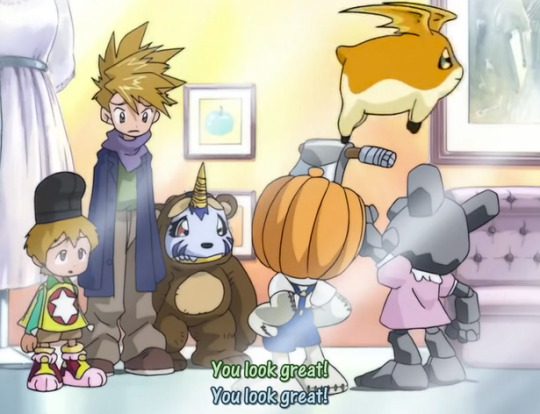
Adventure (+ Our War Game), age 11/12:
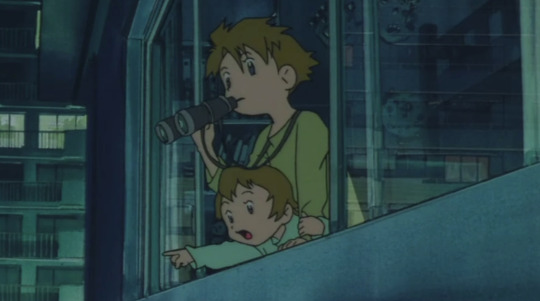
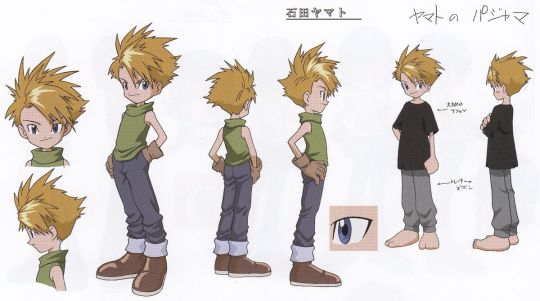
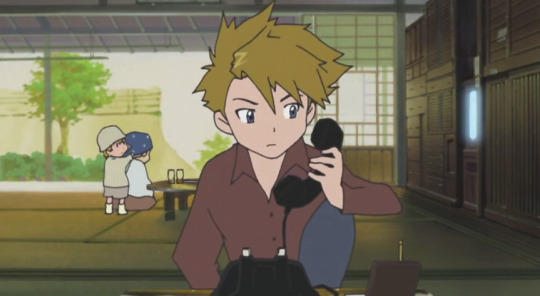
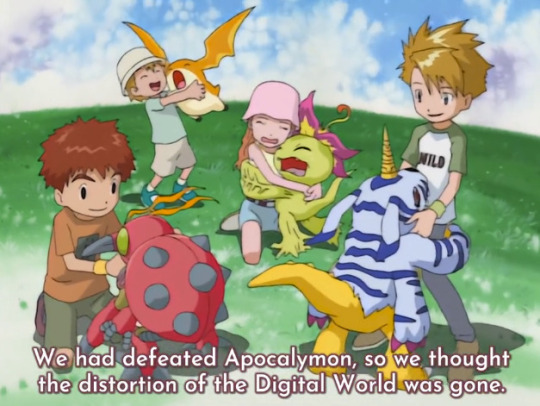
Even though the kids do not change clothes very often throughout the series, we can still find a few of the aforementioned "themes and motifs" for Yamato here: Starting with his signature sleeveless/turtleneck shirt in Adventure, his favourite - and thus associated - colour appears to be green and since he seems to prefer overall dark colours, you will usually (but not exclusively) see him wear darker shades. This can also be observed during OWG, where he wears a dark brown button-down shirt - which will turn out to be a common theme in addition to dark jeans or pants. Plus, unlike most of the other male characters, you will almost NEVER see him wear sneakers, because he's clearly a "boots" kind of guy.
As for his hair, this is where the classic "cool boy haircut" with the spikes and side fringe found its origins (which is also pretty close to how his father wears his hair).
02 (+ Diablomon Strikes Back), age 14/15:
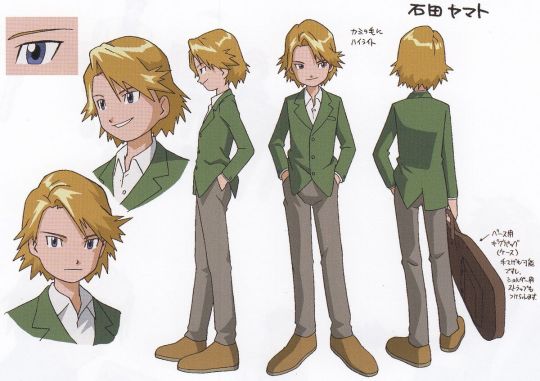
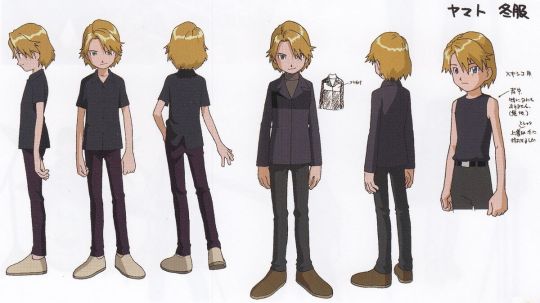

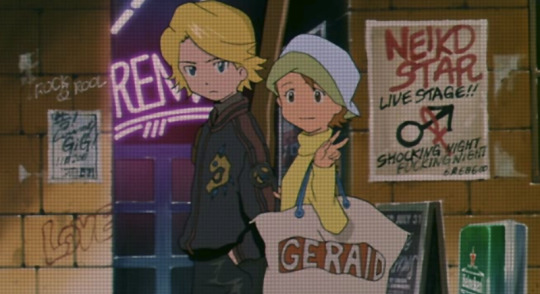
This is where the "rockstar phase" begins and even though green doesn't make an appearance here, he consistently sticks to dark colours - mostly blacks and browns - as well as complementing boots, button-downs or turtlenecks. Despite him being the leader of his own band, his style is something I would personally describe as very neat, almost unagitated and thus more in line with his introverted side - which can be interpreted as him trying to be somewhat lowkey, not intending to attract too much attention. But at the same time, his style (= dark clothes in contrast to his blond hair) naturally creates a sense of "mysterious aloofness" (as it may be described by his fans, such as Jun. While it is also never explicitly stated, we know that he has European/French genes from his mother's side, so this may or may not add to his visual appearance easily attracting attention and popularity).
In terms of his school uniform, he doesn't go all out on being extravagant either, but instead chooses "the middle ground" between Taichi's "loose and casual" and Koushirou's "neat and correct" style by wearing the blazer closed but leaving out the tie. It's still overall very correct, with a hue of "coolness".
Diablomon Strikes Back then adds two more motifs for him, implying him becoming more and more comfortable growing into "his own": From this point on, we will see him wear little accessories like rings and necklaces - which, as we will see later, may even have a link to Gabumon one way or another. He also starts to wear more layers from now on, such as (college or leather) jackets - which will become more prominent later.
The "cool boy haircut" has grown out a little, softening the spikes. Not only could this be seen as him "differentiating" himself a little from his father (which is a common interpretation of the hairstyle change); it also gives him more of a J-pop-star vibe and makes him appear more "chill" in general (whereas I can only assume he was considered more of a "surfer boy" in Western fandoms back in the day).
Tri, age 17:
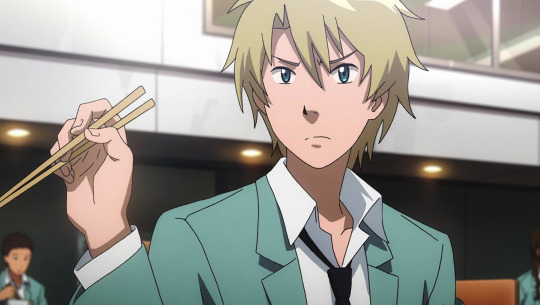

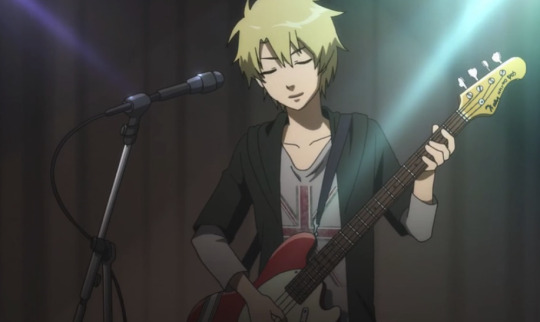
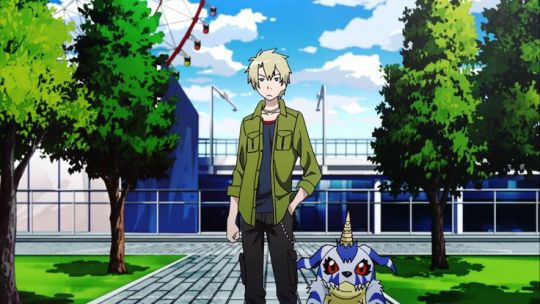
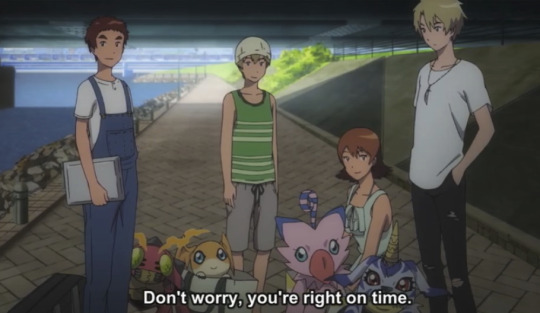

While he has cut his (still softened) hair a little bit shorter again, he overall maintains an effortlessly "casual but cool" style: Not only have the green tones returned to his wardrobe, the boots are also still there (even if they're not visible on the picture evidence). The ensemble is usually complimented by elements from his aforementioned DSB/"rockstar" phase: We see him wearing necklaces and chains in his everyday outfits, simple (black, green or even white) shirts with or without prints and with or without cardigans or jackets - and we can also tell he has gotten generally more daring (and a little less "tame") by wearing ripped jeans.
His school uniform is still more or less "neat", but even though he has added the tie, he wears everything more loosely than he did in 02. For his Summer school uniform, he also chooses to wear a long-sleeved shirt rolled up - instead of the short-sleeved ones all the other male characters wear.
Kizuna, age 22:
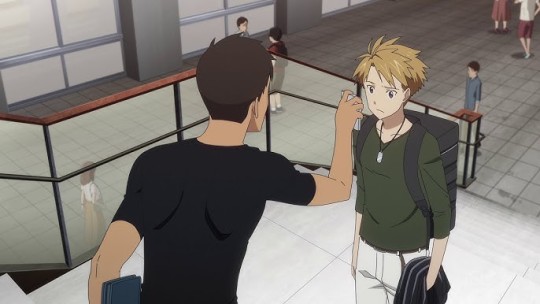
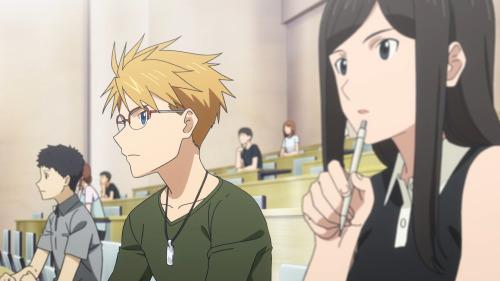
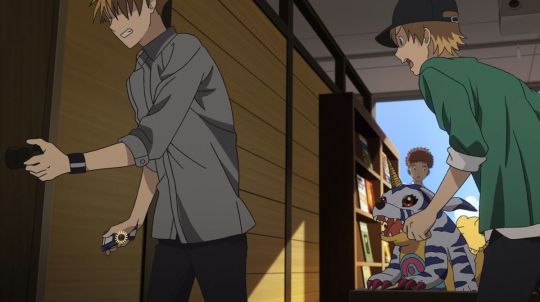
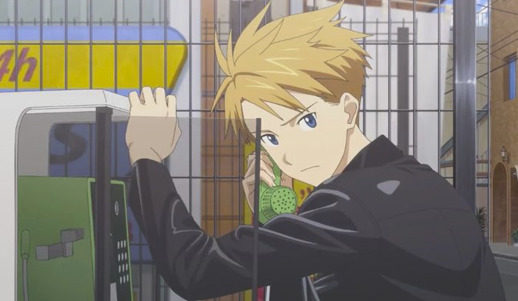
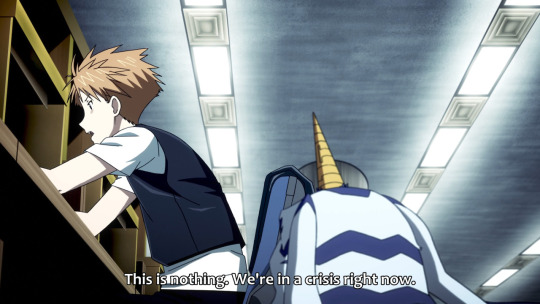

As a young adult, he basically tries to marry the majority of his previously mentioned themes into one consistent style: His signature cool-boy hairstyle - neat, short, spiky - has returned as well as the dark greens and the boots. In general, his colour palette consists of green, black and white - with an interesting case of grey in the middle of the movie. Similarly to Taichi, this may or may not have some special implications: Taichi wears an asymmetrical shirt, black on the left (covering his "heart"), blue (his favourite colour) and white on the right ("light") side, indicating his insecurities in terms of what's the right path. In contrast, Takeru wears all of his associated colours (VERY colourful green shades), as does Koushirou (orange), while also wearing a pristine white shirt - they're both not at risk of losing their partners, they're both on the light side, whereas Yamato and Taichi are completely at a loss. Yamato, who wears a grey button-down shirt, appears to be just as torn about his future and current situation as Taichi is, having abandoned his beloved music and hesitantly contemplating a future in the military. Which is also why he may wear a dog tag - and, as mentioned previously, this may also be a reminder of his bond to Gabumon after all. (And on a lovely little side note, I assume that Takeru starts wearing necklaces at the time of The Beginning to signify his own bond to Yamato.)
In terms of layers, we see him wear leather jackets, blazers and vests, everything being mostly "neat and correct" (again), with the same sense of effortless coolness he always had (but, if you wanna follow Kizuna's course of action, it may also display a sense of insecurity that leads him to choose style cues from the past over trying to move forward. I do like his Kizuna style and there is nothing wrong with returning to what you are familiar with, especially because most of it is definitely and consistently "him" - but that interpretation would also be in line with Kizuna's message, "forcing" oneself to conform and be a responsible adult.) One interesting addition are the red (!) glasses he wears during lectures, which is a colour we haven't seen him consider before. (Since it's "red", a possible interpretation could be that Sora gifted it to him - Kizuna is very persistent with its colours after all.)
Beyond, ???

Now things are getting a little more tricky, because we do not exactly know how old Yamato is supposed to be in these sketches - since this could be Kakudou's interpretation of post 02/DSB!Yamato as well as him being somewhere in his later 20's, also according to Kakudou's vision. I've tried to put my thoughts on this style into words here already, but to summarize it very quickly here: It's interesting that we see the grown-out 02 haircut again, as well as the earring - if we follow my interpretation of 02!Yamato, this only means that he has grown even more comfortable with himself to dress and present himself as less neat and also "less spiky" (= less aggressive in personality).
The epilogue, approximately age 39:
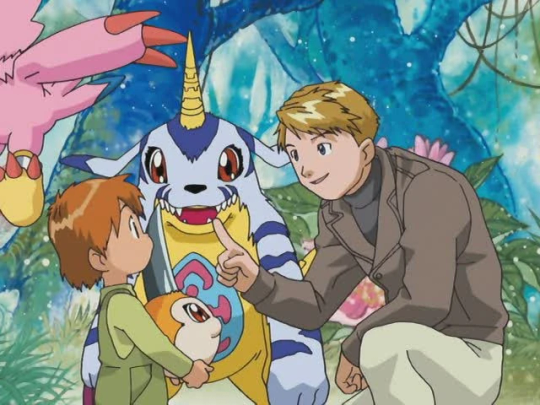
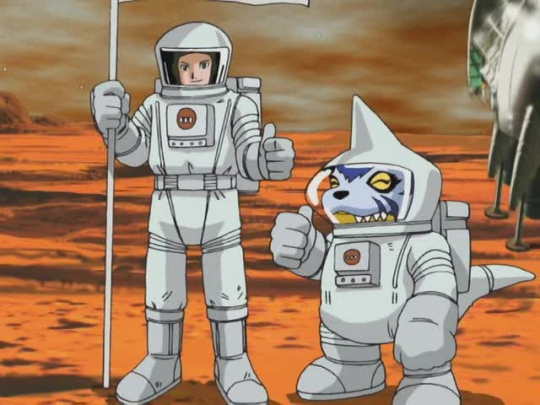
Last but not least, the epilogue shows our astronaut choosing the same colour palette and style cues 02!Yamato had already been famous for: Blacks and browns, glimpses of beige, a turtleneck and a (leather) jacket. His hairstyle is back to being the exact same as his father's - and as for now, there is not a lot to say about that without having the full context of where "Beyond" may eventually lead him in this timeline.
So my final verdict is: As mentioned at the beginning of this post, most of Yamato's style choices have a coherent theme: cool, effortless, mostly unagitated, sophisticated and tame, but with a glimpse of growing "rebellion". You can tell he confidently knows his favourite colours - mostly dark greens, black and brown with softening tints of grey, beige and white. He loves his (short or no-sleeved) shirts (with or without print), button-downs, turtlenecks and boots - and sometimes even dares to put on something like leather jackets or vests over those. What he appears to be a little unsure about is the consistent usage of accessories - and his hairstyle.
While the dog tag may be one of his more prominent features at this point (potentially signifying his bond with Gabumon), the state of his hair may or may not indicate how comfortable he is with his identity. Next to Taichi and Sora - and due to him still dealing with the aftermath of his parents' divorce -, he is the one who struggles the most with where he sees himself in the future. We know he has a high sense of responsibility (especially for those he cares about) and tries to find rational solutions, but may let his emotions get the best of him sometimes, hindering communication, so that may be where the inconsistencies stem from. While his clothing style is mostly tame and neat, indicating his wish for order, it has these little moments of (emotional) "rebellion" in it at times; rings, necklaces, ripped jeans - all things he tried out at some point, but doesn't seem to be 100% sure of, since he doesn't consistently wear them. Whether that's because he feels like he has to conform and fit into society as he grows older, abandoning music because it's not a "feasible career" - or simply feels more comfortable wearing his signature haircut (and "what he already knows") once again. One could also interpret his return to his old hairstyle as a sign that he may have grown closer to his father, thus feeling more comfortable "merging" all these style elements and finding a middle ground, slowly but steadily - but whether or not that is true, I am not able to tell.
#yamato ishida#matt ishida#my two cents#meta#fashion analysis#digimon#digimon adventure#digimon adventure 02#digimon adventure tri#digimon adventure last evolution kizuna#digimon adventure beyond
73 notes
·
View notes
Text
Drifting - Part 12
“Drop zone approaching. Get ready.” Called the dropship’s pilot from far up in a cockpit somewhere. Casper’s body was encased in his own pilot casket and felt none of the violent shaking and sudden drops as the craft rapidly dropped into the atmosphere, heating its belly until it glowed a brilliant orange.
However, the rig that the young man was piloting, still shook and rattled in its clamps. Thanks to the fearless sensations of piloting such a sturdy piece of machinery, unlike his body that was fallible; he never felt worry or fear from these worrying judders.The optics of the mech were already online and scanning the bay carefully. He’d zoomed in on the only other creature, a geckin, that was in sight too many times to count already. Casper shut off the optics as the geckin, unaware it was being observed, picked its nose before happily consuming the prize it had retrieved.
[Grim.] Casper sent, mildly annoyed that emotions never came across in the text-like messages the two pilots could exchange without speaking.
{What?} Qik returned, in a separate craft that likewise, was dropping into the combat area.
[Our benefactors. Just watched one put their whole ass hand up one nostril.]
{Yummy. Looked like your breakfast, didn’t it?}
The nutrient slop, or ‘slurry’ as they oh so appetisingly called it, was what Casper had to eat both in the morning and at night if he wanted to maintain his already drastically lowered weight. It had the consistency of the word ‘goop’ and, now it had been pointed out to him, the colour of geckin snot.
[I am literally never going to eat again.]
Casper didn’t get a reply, but clicked his optics with the feeling that Qik was laughing or grinning in her own rig at his words. They remained in silence for a minute more before the geckin Casper was watching touched a hand to his own ear before making his way to the exit.
“Inbound! Ten seconds!”
The digging geckin fled the room as moments later the floor beneath Casper’s feet opened and a roaring wind blasted up and into the space. The young pilot couldn’t tilt his body down, so most of his view was obscured by his own body, but he could see a dark, grey landscape far below what would be his dangling feet.
{I’m dropping after you, my original LZ is no good. Get eyes on the operation area, don’t approach yet.}
[Yes ma’am.]
{You’re going to make a fine merc.}
“Dropping!”
Despite not ‘having’ a stomach, Casper still felt a phantom one fall out from beneath him as the sturdy metal clamps that had held his rig steady during the transport, released him as one. Gravity took hold of him, along with inertia and both he and his rig were launched from the dropship at great speed toward an infinite ground. As soon as the mech was cleared, the craft did a sharp upward swing, arcing into the clouds and away from any danger that lurked below.
Casper kept himself upright as he fell despite feeling himself tilt forwards and backwards. Blue streaks of his boosters fired in short, sharp bursts, righting himself perfectly as he threatened to tumble. As he careened toward the pockmarked terrain at speed, the man checked he was coming in at an angle, roughly forty five degrees to ensure he could slide to a stop, bleeding his speed without pummelling the ground at full force.
It wasn’t a danger to do that, but he wasn’t specifically built for that.Some rigs could dramatically enter like that, and it was overall better for them to punch straight down, some even incorporating an air burst landing deployment, igniting the surrounding area of the drop point in an explosion that would merely liquidise the internals of anything organic in the area. Those rigs were super heavies, designed for ‘hot’ drops.
But that wasn’t Casper. He’d never wanted that style of machine. Zeet and he, along with Qik, had chosen from a wide selection of parts to create the mech that ‘felt’ closest to what he would be, if ‘he’, Casper, were a mech and not merely piloting one.
The result? As he fell, he felt light, like he could almost glide down if he wanted to. He felt as if one arrange twitch of his shoulder would get the same from his metal body.
He felt ‘right’.
It took a scant few seconds before his legs hit the terrain with such force it sent rocks and dirt flying all around in a great cloud that obscured him from suddenly awake and watching eyes in the distance for a moment. A fraction of a second later, those eyes watched a dark grey machine fly out of the dust cloud on skis, trailing smoke and dirt in its wake that followed it like vapour trails from a jet.
The mech skidded to a halt a hundred metres away from its landing site, its legs bracing into the skid and a series of three large blue cones of fire slowing him to a halt. It remained still, its two optic ports, scanning and watching the city where the unseen eyes watched it back, undetected by the interloper. The long blade in its hand was not ignored, the machine held it out to one side, the metal perfectly flat. The rain that hadn’t ceased in three weeks, merely pinged and beaded along the perfect edge.
The fisheye lens that was watching, clicked its aperture beforing zooming in rapidly and reading the stencilled text across the interloper’s chest, reporting it to its absent masters.
S P E C T R E
Meanwhile, Casper kept low. He used one hand to brace the front of his mech against the ground as he lowered himself further. Chances were, if there was anyone in the bombed out mega city in the distance, they would have noticed the giant walking mech falling from the sky and causing the same size dust cloud as a building falling over would.
Then again, they also could have dismissed his landing as another shell fired from the distant geckin artillery that had peppered the city with a sustained bombardment before he and Qik arrived for the last forty eight hours. The enemy wouldn’t know when the bombardment would stop, they could use this ignorance to gain a brief element of surprise.
{Spectre, I’m down and inbound. Anything?}
A friendly ‘blip’ began to grow in Casper’s perception. The motion radar, or ‘MR’, along with both ‘friendly’ signals still felt strange to Casper, but it was one of the aspects he had demanded from Zeet. A low profile for himself, but a more sensitive sensor suite for him. He wanted to see the enemy, but not have them see him.
What it meant was, he could ‘tell’ where something was, without needing to look away at a radar readout, or even flick his eyes to a compass with markers. A tiny advantage, but one that had already served him well, way back when he had first fought Qik.
At this time, there was no movement from the dead city.
[Negative Scrub. No one is moving.]
A red mech appeared at Casper’s side, its recon unit briefly turning his way, nodding before turning back. Qik’s mech, compared to Casper’s, felt clunky to the human now. It had none of the articulation his has. When he turned her way to nod back at her, his shoulder pulled back, his arm dropped a fraction. He was fluid. Her whole torso turned, her ‘head’ bobbed, then her whole frame twisted back. It wasn’t her fault, but now the man knew what to look for, he had access to whole other level of movement compared to hers.
She knelt, her body remaining upright, while he stayed low, his legs supporting him, but his whole body brought low by his efforts. His profile was far lower than hers. Still, she knew combat better than him.
He’d seen her in a fight through several of their training sessions. It was one thing to be able to move out of the way of incoming shots, it was another not to expose oneself in the first place.
Casper, or rather, ‘Spectre’ as was his code name on mission, focused up.
The pair of them began to systematically scan the seemingly dead city. Spires and towers were burnt out, some having toppled over. There were ssypno forces in the area, the geckin intel had explained that. Since ssypno equipment was high end and dangerous, it was harder for them to replace it.
Their job was to make this planet expensive for the noble conducting this battle. It was the only language that kind of person understood.
[Scrub, I got a question.]
{Go on.}
[Why ‘Scrub’ of all things?]
When Qik had offhandedly told Casper that her own callsign was ‘Scrub’ she was offended and confused when he barked a single coughing laugh before getting a reign on it. She was deadly serious and rather proud of her callsign. The young man, besides an errant comment, had left it there, but now felt as good a time as any to ask; why ‘Scrub’ of all things?
{Because I scour the battlefield clean. My ops are always described as the cleanest, unless I'm working with someone. They’re always the messy ones.}
[I’m just saying, humans might interpret it differently.]
{You said, but I didn’t spend my career building a name for myself to just change it on a whim. You read?}
[Aye aye Scrub.]
{Right, let's get this done and then we can get paid and you can get a taste of the good life. You ready?}
[When you are.]
Casper urged himself forward as he felt Qik’s ‘blip’ move away to the west, taking a wide route around the edge of the city itself. His ‘feet’ were elongated, turning them into skis that glided across the terrain with amazing ease. His spinal mount, a dedicated jetpack pushed him forwards with vents that could open and close in an instant, allowing him to adjust and change direction with a single thought. He could still walk and run, if he wanted to, but the idea was the ability to lean into the slide and ‘skate’ across the landscape, pushing against the ground with the side of his feet.
The speed at which the city approached and became large, imposing buildings that suddenly dwarfed him, was alarming. He slowed and dropped into a run, then walk, as he made it into the city proper, using the wide streets to fit his mech between the buildings with ease. He kept his blade held low, in both hands, ready to bring it up and swing at a moment’s notice.
Before reaching this planet, Casper had never held a weapon before, but now, with copious amounts of software all feeding him instincts and knowledge that wasn’t his, there was a vague sense of longing for a long range weapon, instead of being limited to the length of his blade.
That said, there was nothing for him to attack. He raised the blade to step around another building before lowering out and ready down the next street, but it was just, yet another, empty thoroughfare.
He didn’t need military software to tell when something felt… off.
[Scrub, do you read?]
{Loud and clear Spectre, what's the situation?}
[Zero contacts. MR isn’t picking anything up and there's nothing in the streets. No sign of any mechanised forces. Are we sure we’re in the right place? Are we getting played?]
Casper couldn’t help but think of the contract the geckins had forced him into. In a desperate need to get something more from the human and his unprecedented lack of drifting when mentally piloting a machine, the geckins had not taken it well when he had expressed he wanted to leave. So much so, the only way for him to ‘win’ his freedom, was to complete the op, without getting disabled. If he wasn’t able to walk away from the op, then the geckins, or more specifically, one of their corpo-nations would *own* Casper outright, changing his designation from a person, to a ‘thing’.
Whilst the geckins hated the ssypno with a passion, a trick or trap to retain access to Casper, might not be outside their morals.
{I wouldn’t put it past the geckins to try something, but if the op is a wash, then they still have to pay us and we’re free and clear. They wouldn’t have fed us bad intel for us to go out here for nothing.}
The Spectre mech peered down street after street, holding the blade out, ready to cut anything that moved or scuttled in half, yet each time; it was devoid of life until he found himself, quite deep into the city.
Closing his optics for a moment, Casper willed himself to send a ping out, searching for *anything* that might show where his enemy was hiding. All he needed as a fraction of movement.
He focused, his mind mentally tuning the sensitiveity of his radar, it sensed the rain, a beehive of noise that was too much, so with an errant twitch of his head, he tuned out the rain. He sensed himself, receiving false reports of a mech, but it was only him. He removed that too. Blind to the outside world, he stayed in place, reaching out with invisible hands, groping blindly for anything.
There were creatures, things that scuttled and things that moved. Living organic creatures of small size. They reminded him of rats, but no rats survived the destruction of Earth to his knowledge. The things were squidgits, vermin if left unchecked, cattle if desired. They scurried and hid in the sewers far beneath Casper’s mech’s feet. Oddly, whilst plenty of the buildings still had these creatures inside, several, were *devoid* of movement. Not a single living thing could be felt by his sensitive suites.
The optics snapped open, and clicked again. Turning his head towards the nearest towering building, he leaned forwards, trying to peer through the destroyed structure to the otherside, but found it dark and unable to see the whole way. This was only one of the nearby buildings that the squidgits avoided for some reason. The building was a husk, burnt out from some unchecked fire, most likely caused by the geckin shelling. The inside was too dark to see anything.
With a mere thought, a floodlight attached to Casper’s head, winked on and bathed the building and its bombed out floors in a brilliant white light.
The sea of cyclops eyes constricted to tiny points as the sea of fisheye lenses reacted to the sudden wash of bright light. In turn, the countless laser cannons strapped to their spines whined as electricity suddenly washed through them.
The MR was suddenly bombarded with with a crowd of movement as the buildings all around Casper came to life.Casper merely ducked as the space his mech had occupied only moments before was dissected by no less than seven beams, all wishing to decapitate him in one fell swoop.
[They’re in the buildings!] He sent frantically, as a wave of scuttling mechanised bots surged from the building and landed on his mech.
Not wanting them on him for a single second, Casper brought his arm up to protect himself and braced his shoulder. Spectre’s main booster, sitting firmly in the dead centre of his back, roared to life and launched the human’s rig into the building and out the other side in a shower of destroyed rebar and materials. The smaller multi-legged technicals were sent flying in all directions, having no hope of holding onto the mech as it punched through a building.
[Jesus!] Casper exclaimed as he turned his head back and watched the buildings suddenly come alive as each floor seemed to disgorge multiples of the round, bulbous, skittering machines in a manner that reminded the man of infestations from Earth. If his rig had skin, the young man was certain it would be crawling.
Remembering his sword, Casper swung it in a downward swipe along the edge of one of the buildings, cutting clean through two with zero feedback as his sword found zero resistance. The metal hulls sparked and fizzled before burning brightly as they fell despite the rain even as they hit the street below.
Bright lines of light lit up the air between the buildings and scorched down the front of Casper’s mech, leaving deep valleys of burnt metal in their wake. Gritting his teeth,a side vent snapped open and a gout of blue flames pushed his mech sideways by pure instinct, breaking line of sight with the swarm and preventing further damage.
{Spectre, report.}
[Contacts! Lots of contacts!]
{I see them, locking on but I need to see more. Just keep moving!}
[They’re crowding me, how are they this organised?!]
{They’re computers, no living crew. They seem smart, but it’s just a swarm. Stick to the plan!}
Casper barely made it to the next intersection where his rig could fit before he saw the bright yellow lines of the spider tank’s weapons cutting into the concrete like material of the surrounding buildings. He practically dove down the next street and picked up the speed again.
As he glided down the road, he saw yet more of the machines breaking through the exterior walls of the buildings and began crawling down towards the ground.
{Head west; towards me. Try and get as many as you can in one long line.}
[Wilco. One conga line, coming up!]
East, North, East, North, South.
Casper used his boosters to jump from corner to corner, flitting from side to side, avoiding and evading the growing crowd that was mere feet behind him. Any building, or even corner of a building that was in his way was destroyed. He felt like a cannonball, fired from its home and would merely bust through anything foolish enough to get in his way.
The bright streaks of line that burnt and destroyed the concrete around him only served to remind him that the enemy was still on his tail. Despite his confidence, he couldn’t let his guard down. Overconfidence would mean his and Qik’s destruction.
West, North, East, North, West.
When he turned down what had to have been a main artery for the destroyed city in the past, Casper could feel that Qik was roughly in front of him in the far distance, she was just on the very edges of his sensor suite’s range. Firing his boosters, his skis slid him down the road until the spider tanks began to pour onto the main thoroughfare from either side.
Using his sword in an upwards sweeping motion, he cut several through their centre mass, but it was a mere handful out of the seemingly endless hoard that was following. He speared several more on the tips themselves, not slowing his escape in the slightest.
From the distance, Casper watched as countless red lights suddenly appeared on the horizon in a beautiful dazzling sunburst. They hung there for a second before the lights turned into red streaks that raced up into the rainy sky, leaving behind white trails of smoke. They then seemingly paused before Casper’s entire early warning system lit up that he was in the direct path of this bombardment, his fiddling with his sensor suite had left him blind to such threats and had him duck in the very last second as they screamed towards their true targets.
They hadn’t been pausing in the sky, they were arcing towards him.
Spectre leaned forward, nearly toppling forwards, and willed itself onwards, increasing its speed until it began to pull away from the amazingly agile spider tanks.
Moments later, Casper could see the bright flashes of explosions somewhere behind him illuminate the surrounding buildings for a brief second. That didn’t matter. If it was behind him, it wasn’t hitting *him*. Relief washed over him as several of the moving, angry ‘blips’ that had been racing after him winked out of existence.
{Brilliant! Just got a few to mop up, but that was excellent!} Qik sent, as Casper rapidly approached where she waited at the city’s edge. From her bulky torso, several flaps opened as he approached and yet more of the red lights were launched from her. The lights were the burners for the rockets that streaked into the sky before taking a harsh turn and streaking into the city, where Casper suspected that they would rapidly meet some of the creepy, crawling tanks.
The Spectre mech shuddered as one, its various metal parts and hydraulics complaining with a loud crash. Scrub ponderous turned to face Spectre expectantly as the remaining targets seemed reluctant to approach, having had their numbers vastly cut down.
[I hate those things!]
{Yeah, MGUs or AATMGUs to be correct. Automated, all terrain mechanised guard units. Nobody likes them, they’re annoying to get out of an area because you have to expose yourself.}
The two machines stood there a moment, facing the city, scanning for any of the MGUs that decided to pop their head out. Whilst they were constantly scuttling, demanding both of their attention, they were staying out of sight for the moment.
{Thanks for being bait.} Qik sent without prompting. Having Casper’s head turn to face her.
[No worries, I knew you had my back.]
{Always.}
Casper was turning to look back into the city and question if they were going to have to mop up the remaining MGU when there was a flicker of a ‘blip’ in his mind’s eye. He had messed with so much of the sensor suite’s settings and was so focused on the city that he couldn’t make out what he was perceiving straight away.
He didn’t even get a chance to send the [What was that?] as a long missile streaked into the side of Qik’s mech, forcibly sending the rig into the buildings and launching Casper backwards with the force of the blast. He rolled in the air, having his legs go over his head, supported by the jets as they turned him rapidly until the bottom of his skis slapped against the ground again. Sparks and debris flew up into the air as his optics searched for the threat, all the while his sensors pinged Scrub.
Casper watched as a new machine, undetected by his own system until now, flew in from the sky. It had solid wings that jutted out of its back, but before he could even observe more of the aircraft, it flew low, close to the ground before it unfolded into a mech, skidding to a halt at the city’s outskirts.
Two study legs slammed into the asphalt of the landscape. Its arms unfurled and without saying a word or even hesitating for a moment, the two arms opened fire with a rain of flashing lasers that peppered the surrounding buildings and Casper’s mech with hits.
The strikes were damaging, several connections and wires were burnt and fused instantly, forcing Casper to reroute connections and energy as he spun away from the gunfire and slipped into the city. Pressing his back against the building that weathered the new storm from the new threat.
He turned his head and saw the smoking remains of Scrub, the mech that contained Qik. Her legs were missing and the torso portion was scorched all along one side. She had been through into a now collapsed building. She didn’t move.
[Qik?] He sent, dumbfounded as laserfire continued over the sound of sizzling rain.
[r/WolvensStories]
[Ko-Fi]
#conservationverse#cuddleverse#human#hfy#haso#humans are space orcs#furry#human x furry#rabbit#lopeljack
31 notes
·
View notes
Text
Track #11: Kraid's Campfire Ballad
youtube
Artist: Sebastian Mårtensson feat. Kristin Björkebäck
Origin: Miniboss Hideout I by Hirokazu "Hip" Tanaka
Length: 3:32
"Kraid's Campfire Ballad" remixes the theme of Kraid's Lair from the original game, one of the defining pieces of Metroid music for its beautifully dark and haunting tone, well-loved despite its lack of reappearances in the series. This remix courtesy of Sebastian Mårtensson and Kristin Björkebäck reenvisions the song as a stripped down acoustic guitar piece, echoing the original's minimalist composition. As the song unfolds, the guitar becomes more intense, until for the final repetition it is joined by accordion and chorus, like it really is being played by cowboys around a campfire.
Before creating this remix, Sebastian Mårtensson had never made a video game remix before. At the time, he hd only recently decided to study VGM composition and had just learned about the Metroid series, and while searching for more about Metroid he learned about the Harmony of a Hunter project. With Kristin Björkebäck's help on accordion (Kristin, Sebastian's classmate, recognized the song as being from a game she loved when she was younger, resulting in the collaboration), he produced this and submitted it. This remix is the first of ELEVEN Harmony of a Hunter remixes he would create (not counting Shinesparkers' other VGM remix albums that bring it to TWENTY), making him by far the most frequent contributor to Harmony of a Hunter. His mixed acoustic style is unmistakable, and has produced several album highlights.
For a beginner's effort, this remix goes above and beyond. Mårtensson's style is a perfect fit for Kraid's Lair, but it still has enough new ideas to have its own identity, and the song builds up perfectly. "Kraid's Campfire Ballad" is beautifully done and is a lovely reprieve between the two very intense Ridley-related songs sandwiching it, giving the listener a moment of relaxing but melancholy reflection (and giving Kraid some time to shine).
Rating: ⭐⭐⭐
Track #10: Ashes to Ashes Track #12: Cave Dweller
#metroid#Hoah#Harmony of a Hunter#kraid's campfire ballad#Sebastian Mårtensson#Kristin Björkebäck#Music#Youtube
4 notes
·
View notes
Text
ULTRAMagic Alternate Lore 12 - Mary Pickford
Previous | First | Next
Master Post
Mary Pickford is an anomalous bounty hunter who appears as an inkblot cartoon character (or rather, that is what she is described as). She is noteworthy for being an unofficial member of The Magic Anomaly Investigation Group (M.A.I.G.) and an informant for The Liger Brigade. Mary has been active since the 1920s, having first shown up in New York, U.S.A. The tale behind Mary is a strange one, with the primary source of information coming from the lead scientist of M.A.I.G., Dr. Reynard Woodall. Making this even stranger is that Dr. Reynard adopted Mary and views her as a legitimate daughter. Just who is Mary Pickford?
Starting with Mary’s anomalous properties, they are as follows:
Strength levels of humans in Universe-23 tend to vary, but typically men and women are on equal footing. Mary exceeds this. She is not as strong as someone like Aoife Crawford, but there have been a few noteworthy incidents.
Mary’s appearance can be best described as a real life, inkblot character. Her proportions are normal and physiology, but she looks as if she is animated and has the most popular inkblot style of eyes.
Very few can actually see her anomalous properties. These are people of great intelligence, higher dimensional level, and the magically inclined. Looking at Mary for prolonged periods of time can distort reality for the individual. This seems to be mitigated in the mentally unstable/irregular for some reason.
All of this is tied to Mary’s aberrant magic ability that she calls “Rubber Hose.” The most accurate way to summarize this ability is that she is a living cartoon character. The ability allows her to distort her local reality to create whatever she needs. Mary has been observed using finger guns that shoot actual ammunition, turning her fists into wrecking balls or anvils, and creating creampies out of nowhere. She can also bend and contort her body in unnatural ways. Regular people do not “see” this distortion of reality and will make up excuses and lies for what they saw. When challenged, these people will become indignant and even violent if pressed hard enough.
Mary Pickford is widely regarded as an incredibly dangerous entity, despite her friendly disposition, with her aberrant ability making her borderline invincible. Fortunately her ethics and psychopomps (dullahans, reapers, shinigami, etc.) keep her in check (why she fears the latter is unclear). Leading the research into the nature of her existence is Dr. Reynard Woodall, given that he is arguably responsible for her existence in the first place. Reynard was attending a party at a speakeasy in the late twenties where they were playing a black and white cartoon. Mary just stepped out from behind the projector and started drinking with the partygoers. Only Reynard noticed the discrepancy.
Reynard promptly bought the film off of its original owner and has been preserving it ever since then. He has been keeping the reel in good condition, making copies with higher quality film, and has digitally recreated the film. The film is an anomaly in and of itself. When watched, the film plays out as normal, but events happen without a specific character. Despite this, average people do not notice anything abnormal. People that can see Mary’s anomalous properties see the issue and report feeling unnerved, akin to observing liminal spaces. Mary has expressed a desire to return to her film, but it is unclear if she can.
Erika Storm (lead scientist of the Liger Brigade) has taken great interest in Mary. Extensive studies have revealed that she is a rare instance of a 2D entity existing within the 3rd dimension. It has been discovered that the 2nd dimension does exist as its own plane of reality, but it is radically different from the 3rd dimension. It follows a strict path with no deviation and its laws are set in stone. This makes sense as higher dimensions need it to function properly. It can be observed, but only through things like art and media.
Things become complicated when dimensional disruptions occur. 2D entities have entered the 3rd dimension before, but it is incredibly rare. Most of the time this is observed as real life stick figures. Even fewer stay around, vanishing into the Unlight or 0D space. Entities as complex as Mary are so rare that she is the only known instance of this happening (keyword being known). Erika has speculated that Reynard’s presence at that party is what brought Mary into existence (Reynard is a former primordial, The Sulfur of Old. Likewise, Erika was The Mercury of Old). This has led to Mary being seen as Reynard and Erika’s daughter.
In regards to Mary’s profession, an explanation of what bounty hunters are is necessary. These are vastly different from the pop culture perception. They are mercenaries, not second-hand cops with no standards. They can be hired for any job as long as enough money is offered. Typically they will check bulletin boards (or similar forums) and take whatever job suits their fancy. Hunters (shorthand for Bounty Hunters) will not advertise their services publicly, preferring to let word of mouth get their name out there.
Another key difference is that the majority of hunters have standards and limits. They still prioritize profit, but will refuse to take certain jobs. Any work that goes after innocent civilians, destabilizes society at large, and/or would disrupt the world’s economy are right out. Hunters may be profiteers, but they are not stupid. Clients who scam or anger hunters are usually ratted out to the authorities. Most of the time these mercenaries will have the money to afford bribes, helped by their low profile.
Lastly, hunters are not proud of their work. It is a dirty job after all. It pays the bills and that is what matters to the sensible ones. Mary is a bit of an anomaly in that regard as she is easily angered by pop culture. Her biggest pet peeve is when “Bounty Hunters” appear on reality television shows. Portrayals in movies, shows, video games, and books do not help either. Mary has gone on record saying that actual hunters would never work out in the open, would not work as second hand cops, and would not sign “hollywood deals” for reality TV. Plus she does not want children aspiring to be hunters given how bad the profession can get at times.
Mary had issues fitting into society at first. She could not find a job she was good at, and the ones that worked ended with her driving her employers mad from her anomalous properties. It also did not help that it was the twenties going into the thirties, but she found something that worked: hunting criminals. She liked this as it felt like she was doing good and she made money from it. It was a win-win situation for her. Eventually Mary started taking slightly more unsavory jobs due to better payouts and the ever changing attitude of society as a whole.
There was a period of time where Mary was basically an assassin. She would be tasked with going after politicians, despots, dictators, CEOs, and other noteworthy figures. Eventually she grew jaded and tired, which led her to stop taking these jobs. Being 2D seemed to allow her to disassociate from the 3rd dimension, but even she grew weary of the mindless killing. Plus she did not want this to be her life. Mary did not want to abandon her profession, but she was going to be a lot more selective of what jobs she took.
Approaching the 1990s, Mary realized that clientele were becoming more bloodthirsty. So many crime lords, mafias, and gangs wanted people dead. They were even threatening the hunters themselves, hiring other hunters to kill them if they did not take a job. Naturally these people vanished due to strange circumstances as time went on, with most hunters not giving a fig. Mary would adopt a new standard to combat this epidemic: she demanded 50% upfront and would feign failure if the target was innocent. If the client went after her, she would simply change her target to the client and take as much money as she pleased afterwards.
Jobs and bounties in the 21st century have been interesting for Mary. Of course there were the typical criminals and crime lords that wanted everyone under the sun taken out, with Hunters having to remind them that their actions would create chain reactions that would backfire on them. In Mary’s case, a mysterious shadow organization known as The ACF has been hiring her on a consistent basis. They have been asking her to retrieve certain individuals and seem to have an unlimited amount of money. Even if Mary fails, she still gets paid a good portion of the initial bounty. And sometimes they just need her to engage with the target in question. Mary has been working to find out who these people are.
This unknown organization seems to work with The Liger Brigade, M.A.I.G., The League, The Devil’s Brew Coven, and The Red Order. Of course getting information on them has been tricky for Mary as The ACF maintains a low profile. Dr. Reynard and Erika have promised to tell Mary about them, but they are slow to reveal information out of an interest of security and secrecy. Some of the people of interest for The ACF have been: Ellen the Wayward, Mazatl Nakahara (Adrien Irons), Dr. Reynard Woodall himself, Erika Storm herself, William Ford II, Valentin Karppinen, Trumna Wintergate, Antares Briggs, Bethany Briggs, Morana Dracul, Vlastimir Dracul, and Dr. Ethan Luminate.
ULTRAMagic Alternate © 2022 William Ford II (ChaoticTempleKnight)
#chaotictempleknight#ultramagic alternate#fantasy#sciencefiction#sciencefictionfantasy#lore#literature#fiction#lore post#character lore#oc lore#writing#writers on tumblr
0 notes
Text
Okay. Here it is. I’m here to tell you about my current, most beloved main source of brairot–Arcade Army!! (title subject to change probably but its what i’m going with for now) Rambling under the cut this was like 2 pages in google docs so.this is your warning😭
Okay so!! The project was first thought up around 2 years ago, but I just picked it up again pretty recently. And oh my god. It’s so fun to make but also it makes me feel physically and mentally ill having all these characters to myself.
The basic premise of Arcade Army is that there’s an arcade with a bunch of games in it (wow, shocker) and each game is a part of its own world. After the arcade itself closes for the night, the place operates in a wreck-it-ralph style where characters can leave their games, go to other ones, or spend time in the connection center, where the games are connected in districts based on their location in the arcade.
In order to tell the story I want to, I’ve been working on creating 12 different fictional arcade games, each with their own characters, worlds and game mechanics. And let me tell you. The amount of ocs I’ve been making.mindblowing. Even the ones that I scrapped ALONE are making me insane (i love them all dearly) Anyway, here’s some brief overviews of a few of the games and characters:
FASHIONMANIA FIGHT CLUB:
In the world the arcade resides in, there’s a popular web game called FashionMania where players compete to create the best outfits in online competition mode, and in story mode work to rise to the top of FashionMania Highschool’s fashion aesthetic-based social hierarchy. Due to the original game’s success, its developers decided the next move would be to create an arcade game with FashionMania’s characters, where main bosses and favorite side characters are opponents in a school-approved after school fight club. Players start by creating an outfit combo using one randomly selected item and 2 other alternating selections of items that they have to correctly time to get a perfect outfit match bonus (think about that one timing game in mario odyssey where you have to jump at the right time at the desert casino place.i cannot explain it better but its like that*). Once that’s done, it turns into a fighting game where they go against the various characters and attempt to rise to the top to be known as the best fighter in FashionMania history! (side note, all characters in both the original FashionMania and the arcade game have a unique animal motif, some more obvious than others)
(*like a slot machine. I meant a slot machine.)
KITTASTROPHE:
The final boss of the FashionMania arcade game, Kittastrophe–known as Katelyn in the original game, Kittastrophe being a title she uses only in the fight club–is the most powerful character of the most popular game in the arcade. Because of this, she co-leads the arcade with Newsflash. Despite being a bit arrogant at times, she takes her job as a leader very seriously and provides help to those who need it. Cat themed, but specific type of cat is undetermined rn
NEWSFLASH:
You know those games where a car is eternally going forward and has to alternate between 3 lanes and avoid things on the road? (like this:

) That’s the type of game Newsflash is!! The game itself is named after its antagonist, a former weatherman that gained the ability to change weather at his will and uses said power to make the player’s drive hell, placing tornados, lightning and hail on the three roads. His power makes him the most powerful person in all of the arcade, much more powerful than Kittastrophe (who he leads the arcade alongside, as mentioned before). Despite his seemingly “evil-for-fun” nature, he wants the best for the arcade, though he has fun playing more into his evil appearance for laughs (though not everyone believes/can tell those types of remarks are jokes, causing some to be intimidated by him). He’s also gay, specifically very gay for one guy in particular–Trevor.

^^ He hovers over the car like that.he’s giant in his game but he can change size when convenient (dont ask about his design yet ive been fighting to come up with something worthy.)
TREVIA:
A trivia game hosted by hit guy Trevor!!! Notably Trevor does not have a head (Or maybe it’s invisible? The world may never know) He wears a blue suit, a pink necktie in the shape of an upside down T (for trevor.because it’s funny. also notably an uppercase T because it is NOT a cross) and white gloves. He’s passionate about his gameshow and an enthusiastic host, but also paranoid and anxious about a lot of things. Unfortunately for Newsflash, Trevor falls into the category of being very afraid of him, and is completely oblivious to anything that could possibly be taken as flirting or even a friendly compliment due to his own overwhelming fear that Newsflash will suddenly decide he wants Trevor electrocuted mid-interaction. He is Bi however so Newsy has a chance!!maybe
(his game is shaped like one of these, except imagine the steering wheels are each 1 big buzzer button with 4 smaller buttons above them to pick abcd for the trivia)

Anyway! I have so much work to do with this but its so fun i do not care at all.this will take me years there is no chance it won’t but progress is progress and hopefully one day i’ll have all 12 worlds (plus the extra secret thing that explains the army part of the title) and all their characters made detailed and set in stone!! The plan is to make it a visual novel eventually (or an rpg if it takes another decade and i get too ambitious) that’ll come out in parts. The game will (hopefully!) include minigames based on the concepts i have for each of the arcade games (though with my very very basic coding knowledge that will be a learning curve in and of itself but hey!! That’s a future me problem)
So! My big main things to do list: 1, Create 30+ unique characters and determine their relationships with the other characters. 2, Design the locations and general “story”/world of each individual game. 3, Design the actual arcade cabinets (minor milestone but important.to me) and 4, tie it all together in story format!!
Also I’ll need to draw all the sprites and backgrounds and stuff but that’s wayy out there (and an intimidating task) so i will not be worrying about that right now! By the time im done with those other parts my art will probably improve enough to make basic sprites so.yeah. Or I’ll enlist people to help me which would probably be a better idea but again those are bitty details right now. Okay expect to either hear either nothing about this for months or ill never shut up about it.buhbye
(also thank you @nami-moittli for the encouragement and for inadvertently reminding me i made a doc last year with like 400 picrew links that i buried in my google drive, that will be very useful for my cause here :))

ohmy god i need to be able to draw decently so bad im going so insane over my oc project IM GOING TOEXPLODE
miight do an infodump type thing about it soon because.ough. oomf. mybrain is rocks in a tumbler slowly yet rapidly turning into incomprehensible mush
#i need to sort through the picrews a lot of them are probably either really limited or deleted😭#when i find the best ones ill report back to tumblr and show them off#nami#i have a template i made for basic overviews on the characters so i need to fill those out for everyone :))#im just having fun man everyone should have a needlessly complicated oc project to work on at any time#also gatekeeping the trevor art because its not good and he deserves a dramatic reveal not a halfassed sketch#arcade army#my ocs#should i tag ocs?? i guess#trevor#newsflash#kittastrophe#fashionmania
6 notes
·
View notes
Text

Previous // Next
Summary for Code:04 is here!
Please notice that this is just a summary so not every single detail is included!
Stormbringer Summary 5
Code 04: Grantors of disgrace, you need not wake me again
Recap: N and Verlaine escaped from the laboratory.
The chapter begins with an excerpt of Rimbaud's diary. He wrote that there was once an anti-government movement 'May Revolution', and the leaders were called 'The Fauns'. They created a secret weapon which was named 'No.12 of Darkness' that can control gravity freely. Once Rimbaud acquired this weapon, he was ordered to educate him and trained this weapon to become a spy, and its name was Paul Verlaine.
- Unbelievable. The Secret of the Gentle Forest was decoded. Here it lies the most fierce beast, and Verlaine...
Rimbaud wrote in his diary.
-
Verlaine and N were at the top of a tower crane. Verlaine had N here because he wanted to know why N knew the Secret. However, N claimed that the last 6 pages of the Secret was erased by Rimbaud himself so he couldn't tell much. Verlaine couldn't believe that's actually Rimbaud who altered the information.
He was strong, Verlaine referred to Rimbaud. He is the only one who was capable of battling with Verlaine in his organisation, and they were partners. Not only this, Rimbaud also called Verlaine his friend, but Verlaine just felt like he couldn't like Rimbaud.
Verlaine left N on the tower crane alone and left.
-
It was a night with a clear sky, a train was moving on the railway and Mori was sleeping inside. At once, a human showed up on the railway, and stopped the train. The train was derailed as a result of mass shock. Verlaine went inside the train and searched for something, and he believed no one inside the train was able to survive after the shock.
Verlaine found the body of Mori, and he approached to confirm the breath. But that wasn't Mori. It was a man who wore the outfit of his, but was not Mori himself. Turns out it was Mori's double, Hirotsu. A tiny person also appeared afterwards, and that's Dazai.
Suddenly, there was light in the dark, and that was flame. By the mountain near the railway, there were 50 and more sniper bullets aimed and shotted Verlaine, and the target was in utter pain.
'Don't think these little rocks could kill me...' Verlaine was trying to use the woods beside him to attack the snipers who were hiding in the mountain, but he stopped
'Hoho- You really look like my subordinate when I take a closer look' said an elegant lady, Kouyou. She summoned Golden Demon and launched offense towards Verlaine.
'You can't beat me alone,' Verlaine said.
'Who said I am alone?' Verlaine then felt his whole body sinking down to the ground, and turned into multiple snakes that were about to swallow him. That was the Lieutenant's ability (reference to Dead Apple manga, former Port Mafia executive), that could manipulate the state of objects.
'Ability organisations are stronger than ability users,' Dazai observed and smiled. Various ability users from the Port Mafia were launching all kinds of attacks towards him, such as the ability of slowing the time and freezing. In fact, Dazai sent 420 Mafia members which included 28 ability users to the scene to defeat Verlaine.
'I will mourn you,' Dazai said to Verlaine, and took out Rimbaud's diary from his pocket.
The next moment, a black wave inflated and spreaded to the whole field.
'-- You hatreds, your dumb torpors, your weaknessses,
And your brutalisation suffered long ago,
You give back, O Night, like an excess,
Un-malevolent, of blood, each month or so, (extract from The Sisters of Charity, by Arthur Rimbaud)' Verlaine said the spell.
The wind calmed, the buzz on the ground vanished as if escaping from something. The invisible waves were flooded in the atmosphere.
'The door was opened,' Dazai observed. A black object appeared far far away in the forest. Right after, where Verlaine were, ejected a form of dark energy. The car that was hit by this energy was completely deformed with half of it vanished and the remains were just like a wrapped paper.
On the mountain, there was a monster who controlled a dark sphere. When people touched the sphere, they died.
No.3 Forces, annihilated; No.5 forces, all dead, No.8 forces, no response, as reported from Dazai's walkie talkie. The mountained was eliminated, and the ground was distorted. All the mafia members were screaming and suffering.
'It's all in the plan, we will win if the next attack succeeds,' said Dazai.
-
Up in the sky of Yokohama, Chuuya and Adam were inside a helicopter and they jumped off from it due to the attack from the monster. Adam was able to fly in the sky because his body allowed him to transform himself into a flying machine.
Similar to Chuuya, Verlaine was also intolerant to poison despite having ample physical strength, so actually it was their plan to approach Verlaine closely, so that they can inject poison into Verlaine's body. It was notable that Adam mixed this poison pill.
It was very difficult to get closer to Verlaine because he had activated his corruption, which he lost his consciousness and attacked the surroundings without rationality.
Nonetheless, Chuuya did put a toxic pill into Verlaine's mouth, which he has his conscious back. Yet Verlaine splitted out the pills right after.
'You always surprise me, Chuuya,' Verlaine spoke. He told Chuuya that once he said the spell, he would have his human personality unlocked and become a mad beast that generated ability singularity. However, that is Rimbaud who thought about adding a spell on Verlaine, which enabled him to get back to a rational form after using his corruption.
'He always thinks about what he could do for me,' said Verlaine.
'But you betrayed him,' Chuuya replied
'Because I wanted to save you,' Verlaine answered.
Suddenly, a finger touched Verlaine's face.
'What an unexpected offense. I bet no one could foresee this. What a joke,' said Chuuya
Verlaine turned back, and realised that was Adam's finger.
'Do you wanna hear an android joke?' Adam's finger was installed with a tiny syringe, and this enabled poison to be injected into Verlaine's body.
'Seems like a child's trick can defeat the king of assassins. Thanks for listening to my android joke.'
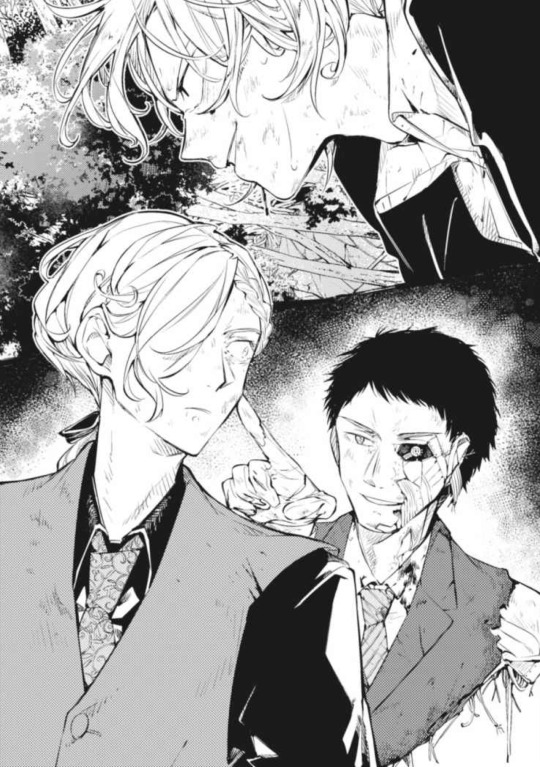
-
It returns to another section of Rimbaud's diary. Rimbaud was thinking about what presents he should give to Verlaine on his birthday. He came up to a conclusion: a black hat. That was not an ordinary hat. The materials used inside the hat consists of 10% platinum, 10% titanium and the rest were made with rainbow-coloured ability metal which was installed with the ability of the Fauns inside. By wearing this hat, it enabled Verlaine to act on his own will and less interfered by external instructions and interruption. In other words, Verlaine was a step closer to a man with free will by having this hat.
Rimbaud gave the hat to Verlaine on his birthday, and he did not look surprised or happy either way.
'Just take it,' Rimbaud told Verlaine, and there was no response. They drank some wine that night and said goodnight to each other.
-
The battle was so called ended, but the field was left with gravity waves and the forest was completely destroyed. Verlained passed out, but still alive. Dazai told Adam and Chuuya that N was rescued from the tower crane, but disappeared during transportation.
-
'I can't die here...' said N. The car that he was taking bumped into a utility pole because he injected some form of medicine to the driver. He took out an old style flare gun and shooted.
'Is this some mistake made by the offense team?' Chuuya noticed the shot far away.
'Shit...' Dazai's eyes were in despair.
The shot that shooted from N's flare gun was exploded with colourful metal pieces floating in the air like snow, and even accompanied with some music. Verlaine suddenly yelled painfully. His eyes were filled with blood and the blood stream was clear on his face and grabbed his chest hardly.
'That was not the effect of my pill!' Adam shouted, 'The gravitational field was unusual here!'
The space was deformed, and Verlaine was flooded inside his own gravity wave.
'The world ends here...' Verlained whispered just like an old man who's dying 'Run, Chuuya.' Verlaine smiled sorrowfully.
The sky was divided, the thunder was coming and the atmosphere was expanding. N saw the ability form of Verlaine. It was a black beast, the opposite of god, and original demon -- Guivre the Beast. The monster annihilated all the aircrafts incoming and was about to proceed to the city center.
'See that Verlaine! That's your end!' N laughed, almost screamed. 'An unique being like you will die because of such a boring creature like me! HAHAHAHA DIE VERLAINE!'
-
Here comes a flashback during the night of Rimbaud and Verlaine's mission of stealing Arahabaki.
'Don't give this kid to the French,' Verlaine was holding the young Chuuya on his arm.
'What?' Rimbaud was confused.
'Don't hand him over to anyone, and don't let him go back to the lab. Grow this kid in a farm and just never let him know about his truth.'
'What are you talking about?' Rimbaud asked once again.
'Think about it Rimbaud,' Verlaine's voice was tense and hostile at the same time, 'If someone tells you you're not a human, how impactful it will be. You are not born with god's blessing but just a programme, how hurtful it is. You cannot see the moon and live in darkness forever without any hope, and no one will come save you. Even such a feeling of despair is designed by someone else!'
'We have this conversation countless times, Paul,' Rimbaud stepped forward, 'You are a human, everyone sees that. Instead of thinking how you were made, isn't it better to think what you should be as a being?'
'Paul...' 'Don't get close.'
'I am sorry. Anyways, should we go back and have a chat?' Rimbaud stepped forward again.
'No, it's too late.'
A huge fight between the spies broke out.
-
Adam had an idea to stop the destruction of Guivre. Almost at the end of the Great War, Britain had developed something that was currently the energy source of Adam's machines. However, the initial usage of Adam's energy source was a mass destruction weapon. Adam smiled and continued. If they used Adam's weapon inside him, they could burn and melt the Guivre.
So they put this in practise. Adam asked Chuuya to tie Adam's own arm to an electric cable. However, Adam pushed Chuuya away when he was about to trigger the weapon. He explained to Chuuya that the weapon inside him was called the Shell (55 minutes reference). It can burn down the surroundings of 22 yard radius, and the internal temperature could reach 6000 degree celsius, and that is almost the temperature of the sun surface. This was sufficient to destroy the Guivre.
'Don't do this!' Chuuya cried
'Don't you have your dream! To build an investigation organisation purely ran by machines right!'
Adam silenced for two seconds.
'My dream is to protect humans,' Adam replied, 'and my dream comes true now.'
'Wait!'
A gigantic fireball. It burned the woods, and boiled the land, and altogether evaporated. The Guivre moaned miserably and decomposed in the air. Adam sacrificed himself and the monster was destroyed.
However, the tail of the beast in front of Chuuya and Dazai was forming into something. That piece of tail suddenly grew a face out of it, something like a reptile. It then turned into a huge form of creature. Its head was pretty much the head of the former Guivre, but the number of eyes were different, and it had red eyes.
'Don't look at it, Chuuya,' Dazai warned, 'He was sensitive to emotion, so don't let him see you.'
'I know how to defeat this ability singularity,' said Chuuya, 'I recalled from my memory.'
'Let's brief me that,' Dazai smiled.
-
They figured out how to open Chuuya's door. In order to activate Chuuya's corruption, he needs to say the spell 'Grantors of disgrace, you need not wake me again'. Together with the hat gifted by Rimbaud, Chuuya could control the door with his own consciousness. However, there's a problem. Once Chuuya said the spell, the log inside his programme will altogether be erased, which means Chuuya could no longer find out whether he was human or not via the programme.
Chuuya was flying in the sky. He grabbed his hat tightly and recalled his friend's word
-- I am satisfied that I can protect you.
And he said 'Grantors of disgrace, you need not wake me again.'
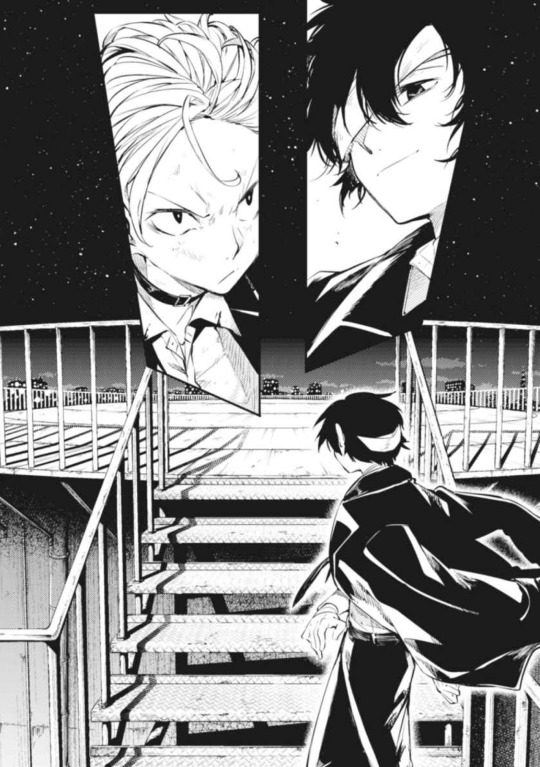
The battle between the gigantic beast and a tiny Arakami (God of Arahabaki) began. Dazai was directing the forces to launch offense towards the beast. Meanwhile Chuuya's physical body could no longer tolerate the power inside his body. He was bleeding severely. Finally, Chuuya created an enormous fireball that was as if the second sun in the night. Finally, the beast disappeared and Dazai nullified corruption.
Code:04 End
#bungo stray dogs#bungou stray dogs#bsd#bungo stray dogs storm bringer#bungou stray dogs storm bringer#bsd storm bringer#bsd nakahara chuuya#bsd paul verlaine#bsd adam frankenstein#bsd dazai osamu#bsd ozaki kouyou#nakahara chuuya#paul verlaine#adam frankenstein#dazai osamu#ozaki kouyou#hirotsu ryuurou#bsd hirotsu ryuuro
259 notes
·
View notes
Text
Let’s Talk Calm-ly about Two Loves
OR: When you’re a grown man who writes stories for a living, you definitely wrote your own weird bedtime story, too.
The TLDR here is that H has taken one specific listener around the globe, notably to Tokyo and Jamaica. He quotes an old Victorian Poet who was an awful human but who’s lasting legacy is the phrase “a love that dare not speak its name” which is - you guessed it - a reference to queer love. He also is super excited to spend what seems like the foreseeable future with this listener and has bought a little house with a garden of daisies with them and it’s very sweet and domestic. Anyways this is a wild time and it’s all under a cut because it’s...really a lot.
Anyways I think the people I owe thank yous this times around to are @queenlokibeth who had to listen to me scream about this for a while, Astrid, who screamed with me when this came out, and “M” who convinced me to finally get to work in this fandom. And, of course, all of the lovely people tagged below who’s work I used to build my argument.
1.) Who Wrote “Dream With Me”?
Well, not H, or so the story goes. Two other people (Steve Cleverly and Sanj Sen) did! I mean, right, okay, for a while I was like...that seems like an odd choice for a man who didn’t want to hand Two Ghosts over to his own band because it seemed too personal. He wrote on every song in both albums’ he’s released thus far, because he seems to be passionate about telling the stories he wants to tell (even if he won’t tell you explicitly what they’re about). But for a while, I was totally going with the flow there, and the rest of this analysis would still stand: the writer of this story definitely referenced a poem by Lord Alfred Douglas and Harry’s own songs.
However, I then read this fun quote from the Co-founder and CEO of Calm:
“Well,” he said, “The the Harry Styles one is interesting because that came purely from Harry Styles himself...we took the approach of creating a sort of musical epic poem – he doesn’t sing, it’s spoken with poetry, but there’s a sort of musical sound bed to it and it’s pulling on things and themes that Harry’s fans really adore about him and associate with him. So his story was driven really by him – we really created a concept around him.”
- Chris Advansun, July 7th, 2020 via @hlupdate
And I thought, hmmm. This does not sound like a project that he was not involved in creating. From this point on (July, 7th 2020), I began to think of it as a three way co-collaboration between him and the other two authors. But this confused me a bit, because there was largely a nonreaction from the fandom. I was waiting for an actual transcript, because I always fall asleep to these meditation stories, but it was being referenced to as some sort of Y/N fic, which was...honestly not what I expected, but also not implausible, thanks to the ~lovely~ image this man has had since the age of sixteen. But also, twitter seemed to be concerned by other things at the moment, and no one was analyzing the story. .
In fact, I messaged a friend the day that this story dropped, because it had been kind of a shit show day on Twitter. Rumors were sort of flying about everyone and everything: had Liam shaved his head? Was he engaged? Had he and Maya broken up? Were Zayn and Gigi engaged? Had they broken up? Did Niall have a girlfriend? (this one was true lol). Were Elounor engaged? Were they pregnant? Had they broken up??? My personal fav was the bald Liam rumor, which he promptly put to rest in LP Act 1 by...having a huge mane of hair.
So then I thought - huh. Why has today looked like this? I’m not saying that there aren’t days that twitter goes wild because of boredom, because there definitely is - the articles about secret meetings in Italy that are coming out this week (8/12/2020) are proof positive. So that definitely does happen, but it doesn’t usually happen on the days that there’s a lot of content. And maybe I’ve just been starved for content in this fandom, but I would consider a 40 minute video quite a bit of content.
Then the transcript dropped. I’m using two as references - this one on Wattpad and also @carl-and-pearl ‘s version here (thank you so much for the transcript!!). We’re going to get into a more detailed description of what’s going on in the story, but the first thing I recognized immediately is that it was first person POV. I knew that going in, based on the number of Y/N jokes going around on twitter. Then I read it aloud, and I realized that it read like a letter. Like an experience specific to the writer and the reader. And while that’s not super uncommon to write about an experience from the author’s POV - I listen to a podcast called Nothing Much Happens: bedtime stories for adults which has a similar concept - I thought it was odd that they were trying to include both the author and the listener. I completely understood why the y/n jokes were pertinent. But at the same time, it felt like something had snagged in my mind - like a particularly annoying splinter.
The conversations I was having around this story - completely based on the content, concept, and my own instinct - was that this story contained specific references to one person. I thought that it did read like a love letter, and that most identifying features would have been taken out, but the essence remained. Which, once I thought about it, was something that H excelled at doing. Think about Sunflower Vol 6 and Adore You and Canyon Moon and even Watermelon Sugar and Golden. Ask yourself, What do I know about the person they are about? They have skin that browns, they have a secret, they have mesmerizing eyes, they’re willing to dance in the kitchen with him (to dancehall), they have a belly, they’ve been through hard times, they’re witty, they have an accent, and they have lips. I know - super specific right?
So the splinter grew into a thorn - what was I missing? And then - when I was looking for something completely different - I stumbled upon this old interview Harry did with Zach Sang and the Gang Show back in 2017. For context, he was being asked about Sweet Creature. As you can imagine, it’s hard for people to believe he wrote such a beautiful love song when he hadn’t ever really had a long term relationship (two hearts in one home?? Who did you move in with, you can imagine them asking. When did you have time?). So what did he have to say about this?
"In my opinion,” he explained, “I think most songs are written for one listener. Maybe there's one thing in there that only they'll notice about them.... It's so much easier to say something in a song than it is to say it to someone and I think it's really amazing to be able to communicate through that and be able to wrap up everything that you want to say in three and a half minutes and say it in a song."
- HS, May 3 2017
By this time, please believe that I was screeching. Seeing this felt like he put into words the exact feeling I had about “Dream With Me”. It felt like a nod to someone that I didn’t know, which made the story hard to listen to, tbh. Although, I will say that when I did finally listen to it, it knocked me out and gave me odd dreams so. Once was enough for me haha!
So my new operating theory is exactly what Advansun said: I think that H was the primary writer/the driving force behind the story. Because of the references I’m about to run through, because it feels like the way he tells stories, and because they admitted to him being more involved than they originally claimed. That’s going to be how I write the rest of the analysis - under the impression that H had a direct hand in the story that was being put forth. However, I think that the analysis itself would stand whether or not he wrote any of it. It would just be a more tenuous reflection of him than I believe it to be.
2.) How Do I Love Thee? In Two Ways.
Before I jump into the story, let’s talk a little about the poem that I want to compare it to: Two Loves, by Lord Alfred Douglas. Let’s be clear this is not at all a defense of who Bosie was - he was a terrible person, particularly in his later years, when he’d converted to Catholicism and turned his back on his younger self, and his partner, Oscar Wilde. He was violently anti-Semitic, and turned his back on his own community. I want to get this out of the way because I very much believe that we should examine artists for who they are. That is, after all, what I am trying to do here.
But his poem Two Loves has often been used - much to his disappointment, I’m sure - as an exploration of queer love in Victorian times. A line that I will be exploring more deeply in a second was in fact used against Oscar Wilde in his trail for indecency . He attempted - unsuccessfully - to explain it away, but it was too blatantly about their relationship for even the British Victorian society to ignore. I really, really recommend a read of this poem, because it is - despite it’s author - a good piece of work, which explores the themes of shame and love and longing between two men in that time.
I’m going to start with my own background, as someone who’s analyzed fandoms before. I first came across this poem in the Sherlock fandom, with this analysis by @the-7-percent-solution, when I was running in that fandom, and she explains the poem brilliantly in just a few lines. I’m going to take a little longer to run through it, but if you want a concise explanation and a brilliant meta, I encourage you to run to their blog and check it out. That fandom taught me most everything I know about catching symbols and recurring themes and “clueing for looks” and I love it desperately, still.
But we’re here to talk about this fandom, so on with the poem! Essentially, the poem outlines a dream the speaker had: In his dream, he’s standing in a field with flowers - beautiful ones of all kind - and he meets this young man with clear blue eyes and bright red lips and they kiss a bit and have a picnic, and it’s all lovely. If you think I’m kidding, I’m really not. Please, read it for yourself.
Anyways, after they did they did the whole picnic thing, the speaker and his date go on a walk in this field, where they come across two figures. The first is described as,
“...fair and blooming, and a sweet refrain Came from his lips; he sang of pretty maids And joyous love of comely girl and boy, His eyes were bright, and 'mid the dancing blades Of golden grass his feet did trip for joy; And in his hand he held an ivory lute With strings of gold that were as maidens' hair, And sang with voice as tuneful as a flute, And round his neck three chains of roses were.”
- Two Loves, 1894
The speaker, however, was drawn to the second figure:
“He was full sad and sweet, and his large eyes Were strange with wondrous brightness, staring wide With gazing; and he sighed with many sighs That moved me, and his cheeks were wan and white Like pallid lilies, and his lips were red Like poppies, and his hands he clenched tight, And yet again unclenched, and his head Was wreathed with moon-flowers pale as lips of death. A purple robe he wore, o'erwrought in gold With the device of a great snake, whose breath Was fiery flame..”
- Two Loves, 1984
Of course, the speaker immediately asks the second man who he is. The second man says, “My name is Love”. The first man corrects him quickly:
“ He lieth, for his name is Shame, But I am Love, and I was wont to be Alone in this fair garden, till he came Unasked by night; I am true Love, I fill The hearts of boy and girl with mutual flame.”
-Two Loves, 1984
The second man sighs and acquiesces, “Have thy will. I am the love that dare not speak its name.”
It was, of course, this last line that really gave the meaning of the poem away. It was the line that was put to Oscar Wilde as proof of a romantic relationship, it was the line that went down in history as a way to refer to queer love, and it was the line that first stuck out to me when I was reading “Dream With Me”.
The reading here is clearly that “Love” is the love that is acceptable to society - easy, sweet, and cherished. “Shame” is the love that happens in secret - beautiful, alluring to the speaker, passionate, anxious ( as can be seen in the clenching and unclenching of his hands), and proud. He refuses to call himself as anything but what he is. The first man may call him Shame, but he refuses the name, and instead, offers a qualifier to his own descriptor. He is still love, he is just the love that can’t be spoken about.
3.) Walking in Golden Fields of Sunflowers
Now let’s talk about “Dream With Me”. I’m ignoring the first few stanzas (from the line “Have you ever wondered” to “What the two of us can find”.) because those are pretty standard introductory paragraphs to a guided meditation. So we start with the line “Let’s travel now to moonlit valleys...”.
I’m going to do the same thing I did with “Two Loves” first. I am going to describe literally, in general terms, what happens in the story. Warning, I change pronouns from “they” to “you” because the whole thing confuses me, but note that I’m always talking about the speaker and the listener:
So after doing the standard intro, the speaker and the listener take a walk through the woods enjoying nature, particularly the grass, the trees, and the blue sky above. You’re already clearly in love. Then you’re magically on a raft, with cherry blossoms all around you. If you want a good visual for that, here’s a site that has pictures from a boat rental in Tokyo where you can snuggle on a raft in the Chidorigafuchi moat. And then suddenly it starts raining, and they (you) watch the rain for a hot second, and then the scene magically shifts again, and you’re under a porch (although I guess it could be the boat rental’s porch. They do usually have covered areas).
Kind of furthering that theory, they then lounge by the shoreline, skipping stones and hanging out, looking at the snow capped mountains. In case you’re curious, because at this point I sure was, you can see mountains from certain areas in the city of Tokyo.
Anyways, then it’s snowing, and you’re magically in a cabin, just chilling by the fire, and you fall asleep again. You wake up somewhere else.
Where are you now? Well, you’re on a tropical island filled with palm trees. As an American, my mind immediately jumps to the Caribbean, but I suppose it could absolutely be in the Mediterranean as well. The island has white beaches, mangroves, a turquoise ocean, and a gorgeous, peaceful atmosphere.
If you’re curious as to what a mangrove looks like - and I certainly was - they are a group of trees and shrubs that live in the coastal intertidal zone and Jamaica is doing a massive restoration project involving primary school children to regrow this vital part of their ecosystem. More interestingly, there currently exist no mangrove forests in the Mediterranean, so my initial feeling that this scene would take place in the Caribbean was correct. On that note - again, because I was curious - Jamaica has gorgeous white sand beaches with turquoise oceans.
But I’ve gone off topic again! After you’re minds are “in tune” once more (trying to find a heartbeat, anyone?), you reappear in a meadow, with beautiful flowers of all kind, where you are now walking hand in hand through a field of sunflowers, which give the feeling a “warm and golden hue”. Then you come across a little farmhouse with daisies poking out (clearly I have no way of locating this anywhere in the world, but I assume that the UK has both sunflowers and daisies). It’s an empty house which was loved and left because of the passage of time, which inspires my favorite line in the poem: “ The thought of passing time inspires/A feeling that grows stronger”. It’s just...really sweet to me.
So, of course, they do what anyone would do when they come across an empty farmhouse, they go inside. And there, they begin to fall asleep, reflecting on all they have just seen, referencing other scenes of the poem: “ Moonlit valleys, Burdened forests, Gazing at the ocean. Summer meadows, Tranquil sunsets steeped in emotion”.
The next few stanzas are just going to be copy-pasted, and then I’ll go into them a bit, but this is the end of the poem, so they’re the final reflections;
“The tenderness we feel When we are close Two minds as one Surrounds us and connects us But we’ve only just begun.
For now we dream together Of all there is to follow. And know that sleep will keep us safe From now until tomorrow.
Maybe all the memories That we’ve gathered here tonight Are all dreams now remembered Or wishes in plain sight.
No matter what They’re with us now. For this night and forever. And every time we close our eyes They’re yours and mine to treasure.”
- HS, Dream With Me, via @carl-and-pearl
And that’s it! The literal story, in short, is that you started in a forest, then went to Tokyo (maybe) and then Jamaica (perhaps) and then back to a field of sunflowers and daisies in the UK (which is also a guess, it could be Italy or France or Idaho for all I know, but let’s call it an educated guess).
4.) My Dream Journal
So now that we know what happens in the story, how do we interpret this? Well, There are a few lines in the poem that I want to draw your attention to: the first takes place in the first part of this story, when you’re still in the forest. This is, I must say, the most direct reference to Two Loves in the whole poem/song/story. Both works are describing a walk in the woods with your loved one, and, in a fun reference in the middle of the story, Dream With Me says
The shimmering reflection Shows us smiling from above. But what we think But dare not speak is L-O-V-E love.
-Dream With Me, 2020
Remember that line I mentioned before? I am the love that dare not speak its name. Right, so that’s almost a direct quote. It also has a really fun nod to “I Would” (Would he say he’s in L-O-V-E?/Well if it was me then I would), but I digress.
This first part of the narrative, I feel, really sets up what the rest of it will look and feel like, in the same way that “Golden” sets the tone for Fine Line. (You didn’t think I was going to make a post about Harry and NOT mention Golden, did you?? If you did, I’m disappointed!!). So let’s take a look at what’s happening, and the language he’s using to describe it.
One of the best things about this poem is how vivid it feels. Of course, I’m about to argue that it’s vivid because it was based in reality, but let’s talk about the sheer amount of detail he uses to describe the place he’s walking through. The valley (canyon lmao) is moonlit, the grass and the leaves make mosaics of green, you’re walking by the heather (the symbolism of heather is good luck, admiration, and protection), the sepia sunlight breaks through the trees.
You know what it kind of sounds like? Sweet Creature. You’re about to roll your eyes at me! I can feel it! But listen, okay?
“Sweet creature Running through the garden Oh, where nothing bothered us But we're still young I always think about you and how we don't speak enough”
Which, to be honest, sounds like what they’re doing. They’re walking through the garden in the sun, not daring to speak about the Love that he (they both) feel, and instead refering to it in veiled Victorian terms.
And then we head to Tokyo! I know that you’re about to ask me why I think it’s Tokyo versus...idk, anywhere else? Well, for one, he went to Tokyo (to let it go) publicly in 2019. He was there for a few months, and there are some great pictures of that time:

Look! Here he is with his club owner friend and his dog, and a fun red bandanna! But let’s be honest, the dog really steals the show here. But wait! there’s more! More dog content, too!

This was on Jan 31st, 2019, and he’s taking the dog for a walk! Very cute! If nothing else, he spent a lot of time with dogs in Tokyo! And the city fits the description of the story. So I feel rather comfortable with my interpretation that this first date is a memory of this trip - or another - to Tokyo.
So what did “you both”do in Tokyo? Well, chill on a raft while the cherry blossoms flutter around you, clearly. You also refocused your purpose. What did he do in Tokyo in 2019? Well, he took time to think about and write songs for the album he was about to go record. Kind of like refocusing on what’s next, right? And then, in the story when “you both” had time to think amongst the lake and the water and the rain and the moon, and you’d come to the conclusions you needed to, you left. What did he do when he did the things he needed to? Well, he left, too.
And where did he go? Well, in real life, I suppose he went to do his job. But, in the story, you’re meant to be falling deeper and deeper into sleep, so it’s sort of like traveling backwards, you see? Like counting down to one. So you end up on this island with turquoise ocean and mangrove forests. I’m calling this Jamaica. Why? Well, the description fits, for one, down to the four types of mangroves that exists within its ecosystem.
And - probably the biggest reason - I can place him there, too. Here’s him in 2017:

I added this picture because the water around him....looks rather turquoise, doesn’t it? Kind of like he’s enjoying his time on a tropical island by the beach?? Oh, and here’s another one!:

The red bandanna makes a comeback!
So what are you doing in Jamaica, according to the story? Well, you’re hanging out, basically. Enjoying the beach and each other, of course! What else? To be exact, “[Your] thoughts dovetail and unify/ In tune two minds together”. I’m so glad that you’re tuned like an old guitar now! Congrats! Really happy for you!
What was he doing in Jamaica three years ago? Why, he was recording his first album, or so the story goes. I’ll tell you something: finding press for that album was literally the most difficult part of this whole analysis. I got a fair bit of the tattoo roulette with Kendall Jenner, and some things about Carolina, but the interview with Zach Sang took me like an hour and a half to find again to link. The fact that a lot of it has been buried is...not great, for posterity purposes. He’s going to want that one day.
But I’ve gotten off track again! We gotta go back and finish our story, right? What happens now? Well, this does:

hahahaha okay, I’m really sorry, but I had to. I’m not, actually, making it up though! According to the story:
“ As minutes turn to hours We drift off somewhere new. And visualize a stairway To a door we now walk through”
- Dream With Me, 2020
So maybe Louis was just...demonstrating for you.
Anyways! Where do you walk out to? A golden field full of sunflowers. You walk for a minute, then come across an old house with daisies popping up out of the garden. And that’s where the story ends. I guess you’ve made that farmhouse feel like home.
Now to the little reflection he does on the outro. The lines I want to bring your attention are: “The tenderness we feel when we are close two minds as one surrounds us and connects us but we’ve only just begun” and “Maybe all the memories that we’ve gathered here tonight are all dreams now remembered or wishes in plain sight.”
Let’s talk about the first sentence first. In the context of finding a home that could be a shared home, and a future, this is very much an “end of the story, beginning of our lives” sort of thing. You’re back from all over, and it’s time to settle down, and see what’s next.
And now the second sentence. I think this is the one that really drives my point about this story being a collection of memories he has - that’s what he calls it. The story is “gathered memories” that might also be called “remembered dreams” (think of how people say of vacations, “oh it was a dream!”) or you might call it “wishes in plain sight”. This feels in line with the rest of the story. In this stanza, he’s sort of letting you in a bit. If I’ve read this right - and I really think that I have - he’s giving the larger context for the story. It’s a collection of memories he’s had with someone he loves.
5.) Cool! Can you prove it?
I mean, I’d argue that if you read this far, I have proved it, but let’s make some more links, shall we? This was called a “muscial epic” that was “driven by him”. I’d argue that if I know my Victorian literature (thank you, Sherlock!), then he definitely does. Then there’s the fact that he quoted it, so. That did happen. And he knows what it means. And even if he didn’t, there were two other people on the story. Someone was more than capable of catching that one, and the fact that they didn’t speaks to intent. They want you to think of that phrase when you read this poem. They want you to think of that walk in the woods while you’re going on this one.
And, as for my assumption that this is for and about one person, well. Think about it. He said that he writes his songs for a single listener. I’m not saying it’s the same listener each time, let’s get that right, but it is always just for one person. With that, and with the assumption that he’s been involved in the writing of this story, I’d say that the same rule applies. He went with someone to Japan and Jamaica (J^2 haha). And, if I had to guess, it was the same person.
Why, you ask? Well, for one, if that weren’t the case, then this poem would no longer be for one listener, it would be for multiple. And, for another, imagine how awkward it would be to listen to it with his current partner and have to explain “oh, yeah that was the super romantic vacation I took with someone else” . And, I suppose that because I think that attitude of “refocusing” and “dovetailing” and “tuning” and getting excited about imagining all of the tomorrows with your partner speaks to a long term relationship breathing easily, you know?
I’m also going to argue that describing the aura around the house as “golden” was intentional, especially when paired with the location - in the middle of a field of sunflowers. Those are both direct references to his songs. And those two songs are particularly linked by the number 28. The third song that features 28 is Fine Line the song, but that’s a different story. Anywho! “Golden”’s bridge just repeats the word ‘golden’ twenty eight times (if you go here , you can count the bridge) and “Sunflower Vol. 6″ ends the song with 28 “boops” (believe me, I wish I was making this up. I’m not.). So then, once again, you’ve linked a story to two already linked songs.
And, even if you don’t buy the intentional repetition, they’re linked another way, aren’t they? The color scheme and the sun symbol. Sunflowers were named because of their sun-like appearance. They turn to face it. They symbolize loyalty and adoration. And then, of course, the sun is - say it with me - golden. And it - like the person in golden - waits in the sky, beautiful and dangerous and constant. And here that symbol is, in a farmhouse in the middle of nowhere. At home.
This whole story feels like you’re taking the time to find that heartbeat that you think you might have lost, and sort of coming back to a space where you understand that this is what you want, now and forever. It feels like finding a home that could be yours forever, and it feels like walking through some of the moments that remind him of that.
It really is rather lovely, if you think about it, especially since he has a tendency to attribute “home” to people rather than place, in his songs. So it’s like. Going all around the world and always being at home.
#harry styles#calm#dream with me#two loves#honestly man#im happy for you#but ewww#be less sappy please#i mean#SOME OF US DONT HAVE THAT YET HAROLD#hahahaha i think im funny#long post ts#idk how else to tag this but im really proud of it#okay now i'll do the penguin song#promise hahaha
558 notes
·
View notes
Text
Summer 2021′s Movies - My Top Ten Favourite Films (Part 1)
The Runners-Up:
20. LUCA – I’ll admit I really wasn’t sold on Disney/Pixar’s coming-of-age fantasy comedy, which revolves around a pair of young sea monsters living off the coast of the 1950s Italian Riviera, who discover they can assume human form when they dry out and go on land on a quest of discovery. Thankfully the strong reviews convinced me to give it a chance – this is a frothy and irreverent romp through an exotically nostalgic world filled with Vespas, pasta-eating contests and found families that’s fun for kids of all ages.
19. FAST & FURIOUS 9 – the high concept action franchise may be bursting under the ever-increasing weight of its own ludicrousness, but it’s still TONS of fun, packed with stunning over-the-top action, colourful globe-trotting and a loveable bunch of misfits we’ve grown incredibly fond of over the past TWENTY YEARS. This time Dom (the irrepressible Vin Diesel) and the team are up against ruthless hi-tech mercenary Jakob (John Cena), a lethal jack-of-all-trades with a dark connection to the Toretto name.
18. REMINISCENCE – Westworld co-creator Lisa Joy’s attempt to make it on the big screen looks set to go down as one of the biggest cinematic flops of 2021, which is a shame because the feature-debuting writer-director has crafted a genuinely fascinating speculative sci-fi noir detective thriller. Set in a darkly dystopian future in which Global Warming has caused the sea levels to rise and society to start breaking down, it tells the story of Nick Bannister (Hugh Jackman), a former soldier who ekes out a living using revolutionary tech to help the idle rich relive their fondest memories, until a life-changing mystery from his own past resurfaces, threatening to tear his whole world apart. Frustratingly, it looks like most audiences are going to bypass this, which is a criminal loss.
17. FREE GUY – after a seven year hiatus, Night at the Museum director Shawn Levy returns to the big screen in fine form with this deliriously inventive fantastical comedy adventure about Guy (a typically on-fire Ryan Reynolds), an NPC in an anarchic, Grand Theft Auto style MMORPG called Free City who discovers his own sentience after falling in love with Millie (Killing Eve’s Jodie Comer), a player with a hidden agenda that puts them both at odds with the game’s nefarious creator, Antwan (a thoroughly hilarious Taika Waititi).
16. EVANGELION 3.0 + 1.01: THRICE UPON A TIME – visionary anime creator Hideaki Anno brings his long-running sci-fi saga to a close with this fourth instalment to his wildly ambitious cinematic “Rebuild” of cult TV series Neon Genesis Evangelion. It’s as frothy, melodramatic and bonkers as ever, packed full of weighty themes and crazy ideas, while the animation maintains this series’ ridiculously high levels of quality and the action is as explosive as ever, and Hideaki brings the whole mad mess to a climax that’s as rich, powerful and thoroughly befuddling as the saga deserves.
15. THOSE WHO WISH ME DEAD – Sicario writer Taylor Sheridan returns to the director’s chair (after impressive debut Wind River) with this intense and enthralling suspense thriller adapted by bestselling author Michael Koryta (along with Sheridan and Blood Diamond’s Charles Leavitt) from his own acclaimed novel. Angelina Jolie is (ahem) fiery but fallible as haunted smokejumper Hanna Faber, whose PTSD drives her to protect a desperate boy (Finn Little) who’s being hunted through the wilds of Montana by a pair of relentless assassins (Aidan Gillen and Nicholas Hoult).
14. CRUELLA – far from the clunky cash-in retcon many were predicting, Disney’s ambitious black comedy crime caper does a thoroughly admirable job in delivering this fascinating and deeply compelling reimagining of the story of rogue fashion designer Cruella de Vil (one of the best performances I’ve ever seen Emma Stone deliver, hands down), the dastardly villainess of 101 Dalmatians. She’s certainly far more complex here, no longer a raging monster, but far from a whitewashed PC apologist, either, much more of a morally grey antihero with a very wicked dark side – then again, with I, Tonya director Craig Gillespie at the helm it’s not really a surprise. Richly designed and dripping in spectacularly adventurous period detail, this is an divine romp from start to finish.
13. THE GREEN KNIGHT – the latest feature from writer director David Lowery (Ain’t Them Bodies Saits, Pete’s Dragon, The Old Man & the Gun) is as offbeat and unusual as you���d expect from a visionary filmmaker with such a wildly varied CV. Adapting the fantastical chivalric romance Sir Gawain & the Green Knight, he’s crafted what’s surely destined to be remembered as the year’s STRANGEST film, but it’s a work of aching beauty and introspective imagination that sears itself into the memory and rewards the viewer’s patience despite its leisurely pace. Dev Patel is unbearably sexy and wonderfully complex as Gawain, while Sean Harris delivers show-stopping support with stately charisma and world-weary integrity as King Arthur. This film is sure to divide opinions as well as audiences, but I think it’s a bona fide masterpiece that must be seen to be believed.
12. CANDYMAN – after watching this wildly imaginative and frequently gut-wrenching soft-reboot/sequel to Bernard Rose’s acclaimed adaptation of Clive Barker’s short story The Forbidden, I feel supremely confident about emerging writer-director Nia DaCosta’s coming MCU breakout with The Marvels. Wisely papering over the clunky previous sequels, this streamlined trailblazing deep dive into the pure horror of the legend of the righteously mad spectral killer haunting the Chicago housing ghetto of Cabrini-Green sees a daring modern artist (Aquaman’s Yahya Abdul-Mateen II) find his latest project turning into a dangerously self-destructive obsession. Writer-producer Jordan Peele’s fingerprints are all over this, but DaCosta clearly shows signs that she’s going to be a hell of a talent to watch in the future.
11. THE WITCHER: NIGHTMARE OF THE WOLF – I wouldn’t normally shout about an animated spinoff to a TV series like this, but I was SO INSANELY IMPRESSED with this brilliant prequel to Netflix’ popular fantasy show (which clearly intends to lay some origin story groundwork for the impending second season) that I just can’t help myself. Recounting the backstory of Geralt of Rivia’s own Witcher mentor Vesemir, this beautifully expands on the already compelling universe the series has created, as well as delivering some breath-taking thrills and chills through some of the most exquisite cell animation I’ve ever seen outside of the greats of anime. A must-see for Witcher fans, then, but one I’d also highly recommend to anyone who likes their animation a bit more grown-up and edgy.
#movies 2021#luca#disney luca#fast & furious 9#reminiscence#reminiscence movie#free guy#evangelion thrice upon a time#rebuild of evangelion 4#those who wish me dead#those who wish me dead movie#cruella#cruella movie#the green knight#the green knight movie#candyman#candyman 2021#the witcher nightmare of the wolf#awesome sauce
19 notes
·
View notes
Text
Oscars 2022: Best Feature Film Nominees Ranked
April 12, 2022
by Inakshi Chandra-Mohanty
1. Drive My Car
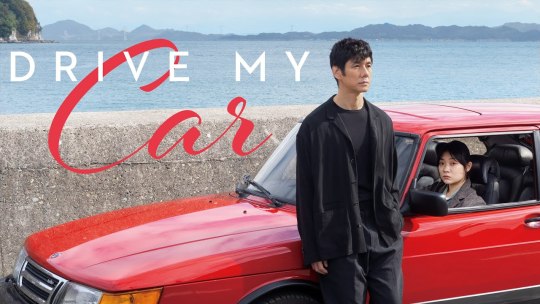
Despite being in a language I don’t understand and set in a culture I know little about, this film felt the most personal out of all the nominations. It’s an engrossing tale of a man struggling with grief and forgiveness. Through his interactions with the various people around him and his deep involvement in the play he’s directing, he gains a different perspective to life. Of those, the most unconventional relationship he forms, is with his driver, as they bond over their respective griefs. Though there is nothing exceptional about the storyline, Drive My Car excels due to the deeply etched out characters and the emotion driven scenes. The film builds an experience revolving around the world of the main character whose grief is personally captivating. His screen presence and the growth in his character are endearing. The film also consists of beautifully framed shots that it even more profound. Overall, it is an enjoyable and powerful film that I will love watching again.
2. CODA
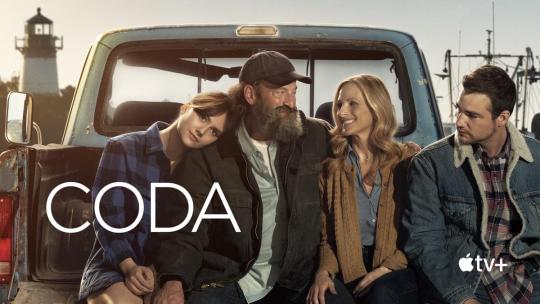
The film that won the title of best picture is the one of the most deserving. A remake of French-Belgian film, La Famille Bélier, with story elements similar to Sanjay Leela Bhansali’s classic Hindi film, Khamoshi: The Musical, CODA follows a child of deaf parents who wishes to pursue a career in music. It is an engaging storyline, with strong buildup, and emotionally intimate characters. We are drawn into the main character’s struggles with her identity and at the same time enlightened about the deaf community. It is an overall package with a combination of drama, comedy, and romance, behind a powerful journey.
3. West Side Story
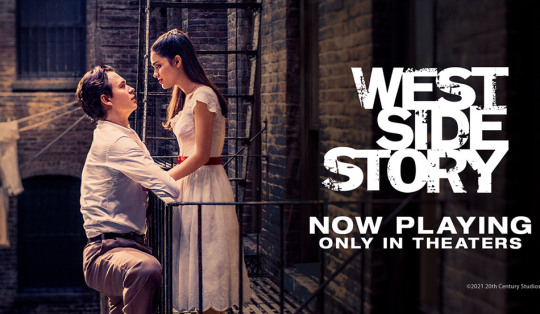
When a classic is remade it struggles to live up to the original and endless comparisons cause it to lose significance. However, as someone who has not seen the original film adaptation or theatre play, and has little knowledge of the plot, I was able to view this film with a fresh outlook. West Side Story is a ridiculously outdated story of love at first sight but Steven Spielberg’s direction makes even the absurd believable, romantic, and passionate. He creates a unique world full of artistic brilliance. The amazing set design and detailed lighting and cinematography are used in a metaphorical sense, a style which is rare in recent films that focus on realism. The use of the visual medium to convey emotions adds much more depth to an otherwise superficial plot and creates an entertaining output. West Side Story is cinema in its purest form.
4. Dune
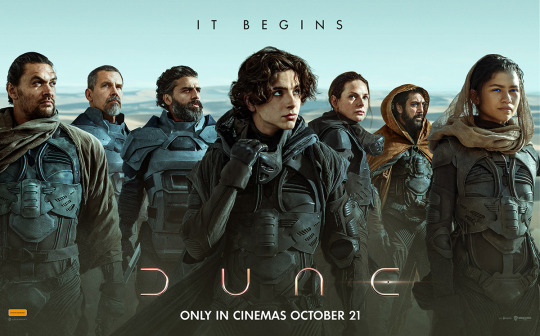
Dune is a visually stunning masterpiece that serves as a powerful origin story for a hero in a science fiction universe of emperors, houses, and outcasts. The film is about the power struggle between outsiders over a land of spices, as the original inhabitants of the planet continuously suffer. This intriguing storyline of a new world has multiple references to real world colonialism. Alongside the symbolism, it also provides identifiable characters, whose mental struggles are not much different from ours. The hero is struggling between two different identities and family histories. His father’s title and his mother’s power clash ultimately leading to an identity crisis within. The film is symbolically, visually, and personally powerful. However, while it is captivating, it isn’t entirely satisfying. The development is extremely slow with focus on pulling us into this world rather than into action. Yet, it achieves its intention and provides a great setup for a sequel.
5. Don’t Look Up

Don’t Look Up is a hilarious satire that uses the arrival of a deadly comet as a metaphor for current real-life issues that can lead to the end of the world. This black comedy portrays “comedic dread” as it transitions constantly and abruptly between comic leisure and resonating themes. It is hilariously depressing which shows how effective it is. While the script is brilliant, the execution veers between a powerful satire and a lengthy comedy sketch, sometimes coming off as a bit too amateurish. The topic is important but the filmmaking could have been better. However, the grand cast, with their brilliant comic timing keep the film engaging as the crisis in the narrative ripples out of control.
6. King Richard

A heartwarming biopic on the growing years of tennis players Serena and Venus Williams, King Richard beautifully shows the contrast between the taste of success and the struggles of being a person of color in America. As these two youngsters rise, they also confront the racism and dangers around them both from outside their community and within. The focus of the story is on their father and his guidance in their journey, giving it a unique perspective in comparison to the typical biopic. But the arc of the narrative is conventional. It has a predictable layout with an obvious conclusion. The journey isn’t unique enough for the film to be too different. However, it is engaging and focuses on important issues making it a worthwhile watch.
7. Belfast
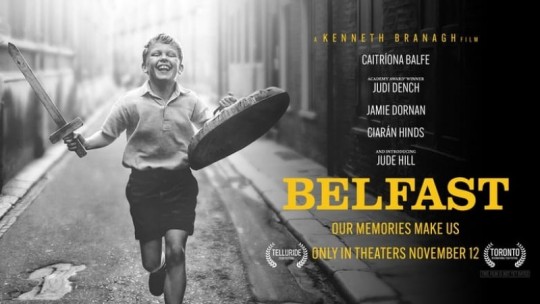
The life of a young boy is transformed overnight as he is confronted with religious divides and cultural disparities in 1960s Ireland. A semi-autobiographical story set in a tumultuous period, Belfast follows a family that grapples with the changing political climate and economic struggles within their community. The themes are relevant to children today who struggle with understanding the difference between “good” and “bad’ as adults around them propagate religious extremism and racial divides. Filmed in black and white, the film is artistically brilliant using the most powerful aspects of non-color storytelling (lights, shadows, and framing). But the story and characters are not impactful enough for the cinematic techniques to have a strong effect. The plot is slightly engaging and enlightening, but not as personal as other critics deem it to be. And there is very little to connect to in the characters, making it an emotionally weak narrative. However, it is a meaningful film, making it worth a one time watch.
8. Nightmare Alley

In a neo-noir remake of the 1947 film of the same name, Guillermo del Toro’s Nightmare Alley follows a young man’s rise and fall in his ambitious drive to boost his psychic career. Though the overall story arc is powerful, the progression is weak. It takes time to develop, focusing instead on visual storytelling. For a majority of the first half, there is no clear direction. Much of the development seems pointless with no proper end in sight. Despite a weak buildup, the film has all the makings of a noir. An ambitious, yet foolish male character, is enchanted by a femme fatale, leading to his ultimate destruction. The camerawork and editing also take the essence of the noir style, with unique framings and contrasting greens and yellows. But the aesthetic visuals are not enough to support the weak script.
9. The Power of the Dog
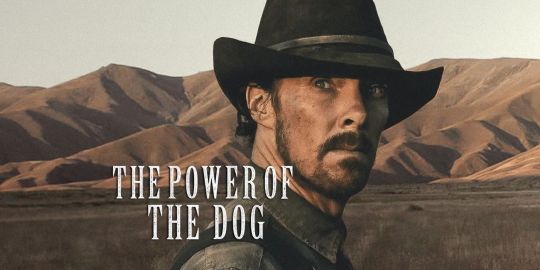
Based on a 1967 novel of the same name, The Power of the Dog, is about a rancher who resorts to intimidation when his brother brings home a new wife and her son. As time passes, however, he slowly discovers and understands parts of himself that he had repressed for years. The film subverts the cliches of a typical Western by questioning the very ideal on which it is built, the idea of masculinity. As the characters struggle with their sense of self, their relationships with one another change, leading to an interesting climax. Thematically and visually the film is powerful, but the metaphors are not worthwhile if the film is not engaging enough. It is extremely slow in the first half only picking up pace as the narrative begins to unravel. The context for that narrative is important but requires much patience and full attention. It includes many scenes of solitude which can be unnerving when there is little emotional attachment to the characters. While the film is certainly impactful in parts, the themes aren’t powerful enough to carry the two hour long film.
10. Licorice Pizza

Licorice Pizza is the weakest of the Oscar nominations this year. It is a coming of age drama about two youngsters who grow, find themselves, and fall in love in 1970s California. While the film is slightly fun and cute, there is nothing spectacular about it. It has a positive start with a unique ‘first meeting’ between two prospective lovers but quickly begins to meander. There is no defined concept which makes it essential for character development to drive plot. However, from the onset there is a disconnect from the two main characters and the period in which it is set. Maybe it is the cultural context, but many dialogues, jokes, and references were confusing to me and is possibly why I personally had difficulty connecting to the film. But, despite its flaws, the film was a decent watch.
#oscars#oscars2022#best feature film#drive my car#coda#west side story#dune#don't look up#king richard#belfast#nightmare alley#the power of the dog#licorice pizza#lists
2 notes
·
View notes
Text
The East Asian Origins of the Fire Nation and Its Villains

Introduction
Over the years, many volumes of fandom blood have been spilled from discussions concerning the Fire Nation’s main villains, Ozai and Azula. Paralleling this have been arguments over their relationships with Zuko, Iroh, Ursa, Mai, Ty Lee, with each other, even with themselves. Since Ozai and Azula are the figureheads of the Fire Nation that Zuko must peacefully restore the honor of, it is worthwhile understanding why people “like them” are considered proper leaders of the current Fire Nation.
Most of these discussions have sought to create “theories” that explain these characters as exclusively combinations of mental illness, personality disorders and various emotional traumas.
A couple examples of these discussions are the essays “Azula, the Embodiment of Jealousy and Neglect,” and “Three Pillars Theory of Azula.” These two essays are just examples, but they capture the widespread strategy the fandom has employed in trying to understand the motivations and goals of Ozai and Azula and their various relationships with the other characters. In addition, the shouting matches between Azula “fans” and “haters” also illustrates these discussions. Since the franchise has yielded so few hard answers, these importance of these discussions has not waned.
What these discussions focus on, as represented by those essays, are the characters’ apparent emotional problems, theoretical moral compasses and perceived inadequacies in the eyes of their families. Typically, the “lens” these discussions view these villains through is one that tries to relate them to present day spousal and domestic abuse narratives, namely as being both “abuser” and “victim” in a cycle of abuse that can be related to the modern, real world.
What these conversations do not provide are adequate explanations for how the historical, political, military and cultural aspects of the Fire Nation molded these military leaders. You would think that people with “Lord” and “Princess” in their names, who train daily for warfare and hand-to-hand combat, would make their responsibilities take center stage in their lives.
While there is a place for “nitty gritty” psychological examinations for understanding certain behaviors, trying to depict the Fire Nation villains as purely allegories of modern day domestic abusers, empathy deficient bullies and people afflicted by personality disorders eliminates Avatar��s most unique and defining characteristic: its East Asian origins.
You don’t need beautiful animation, martial arts-styled bending and immersion in a fantasy world to explain how families in the modern era can hurt their children for petty reasons. We have that in our own lives. We have friends and families who have experienced that. It can be addressed in any other setting. It can be addressed in Avatar but it doesn’t need Avatar to address it.
What we don’t experience in our modern lives is ancient China 2000 years ago, or feudal Japan after the takeover of the Tokugawa Shogun, or religious monks living in their temples in the mountains untouched by the modern world, and so on.
The setting of Avatar is one of both beauty and relative detachment from the real (and modern) world, but it is one that is based on a period of history and human civilization that most of Avatar’s audience (North America and Europe) have little exposure to. If the characters’ motivations are too detached from the fictional world in which they live (i.e. by ignoring the historical, political, military and cultural context), then you begin to lose the world’s depth. At the same time, if their motivations are too connected to the present world, then all Avatar is is a visual motif of ancient East Asia.
By seeking to explain the Fire Nation villains as embodiments of modern psychology’s understanding of “bad” people, you erase the opportunity to apply East Asia’s very real history of warfare, monarchical domination and oppressive cultures to a fictional world that is trying to say something about that warfare, monarchical domination and oppressive cultures. Note that the show did in fact achieve this with the Dai Lee’s corruption and manipulation of the Earth King; it depicted loosely the very real occurrence of Chinese Emperors being “kept in the dark” by their advisors so as not to interfere with the “real” governing of the states.
If your goal is to view Avatar purely as an allegory for modern dysfunctional relationships and domestic abuse, you lose Avatar’s uniqueness as a fictional dive into an East Asian-inspired world, especially one that is ravaged by warfare and feudalism.
In this article, I describe an alternative model for understanding the Fire Nation’s culture and history, and how its politics and military molded its heroes and villains.
What We Know and Might Know
In order to fill the gaps in our knowledge of the Fire Nation, we first have to understand what is both known about the Fire Nation and what can be reasonably presumed about it.
First, what do we know about the Fire Nation?
1. The Fire Nation is an archipelago with a history spanning thousands of years.
2. The Fire Nation was originally the “Fire Islands” and was not initially governed by a central power.
3. The Fire Islands had a unified cultural and religious authority in the form of the “Fire Sages”.
4. Eventually, the Fire Islands were unified by a single power—the “Imperial Government”—and afterward became known as the “Fire Nation”.
5. The Imperial Government is headed by a supreme ruler: the “Fire Lord”.
6. The Fire Lord is a hereditary monarch whose family is considered the “Royal Family”, both of which are separate entities from the Fire Sages.
7. The Fire Sages remain a distinct entity from the Imperial Government.
8. Both the Fire Lord and Royal Family are military and administrative rulers.
9. The Fire Lord and their Royal Family are not sacred and everlasting; their power can be “challenged” by rival leaders.
10. Fire Lords are expected to “show their worth” and be competent fighters in their own right; prowess in military arts and control of subordinates are valued traits.
11. Agni Kais are a longstanding component of Fire Nation culture.
12. The Fire Nation experienced an “unprecedented time of peace and wealth” during the era of the Fire Nation, not during the era Fire Islands.
Next, what can be reasonably presumed given what we know?
Something necessitated the Fire Islands becoming unified, but this unification did not result in the Fire Sages taking power, nor did it yield a peaceful, democratic government.
The Imperial Government that resulted from this unification is rooted in military control and maintaining the fealty of its subjects; in Avatar and the Fire Lord, Sozin put on his “ruler persona” to Roku initially before acting friendly, only later to demand loyalty from him as if Roku was any other subject.
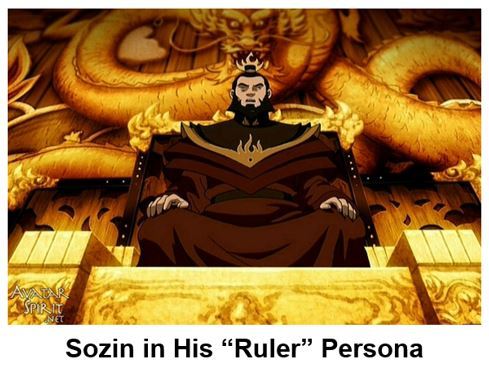
The culture of the Fire Nation values strength and bravery from its firebenders, as explained in an official description of Agni Kais. Presumably, the Agni Kai predates the era of the Fire Lord and has been used to settle disputes of various kinds. This could be interpreted as a “non-destructive” means of avoiding war and greater loss of life given how easily firebenders could wreak havoc to wooden buildings and crops (among other flammable components of society). Since nobody recognized Zuko on Ember Island in The Beach, despite his obvious scar, severe scars from burns must be common enough in the Fire Nation that a teen boy having one on his face is not horrifying nor particularly unattractive.
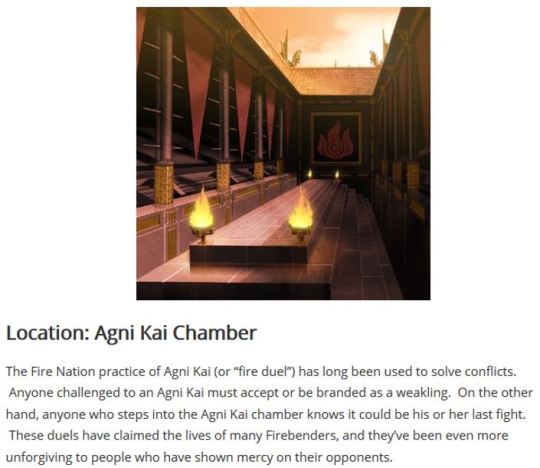
Presumably, the Fire Nation/Fire Islands used to hold its religion and spiritual ties in higher regard, but Sozin’s start of the war required this aspect of the Fire Nation to be suppressed, as implied by dragon hunting and the divided loyalties of the Fire Sages at Roku’s temple, and the fact that various generals and admirals have defected. At the same time, vast enough swaths of the country and its leadership did follow Sozin’s path, considering that he and his family remained in power for over a hundred years. If Fire Lords can have their power challenged, then either nobody tried to stop Sozin, or they were defeated. Azula’s comment about “rumors of plans to overthrow him (Ozai)” in The Avatar State implies betrayal of the Royal Family is not a dormant threat. Though she was technically lying, it must have been a credible lie since neither Iroh and Zuko thought it was preposterous; his brother being “regretful” is what puzzled Iroh, not that there would be plots against the Fire Lord.
Notably, the Fire Lord’s throne room changed between the start of the war and the present day. Prior to Sozin, it did not have the imposing wall of flame as it does now. Certainly it had to be rebuilt after Roku destroyed it, but the wall of flame is much more imposing than the old.
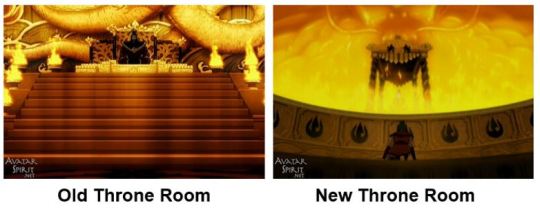
The Fire Sages still pay a role in the Fire Nation, but this role is not known. Presumably, they play some part in the succession of the Fire Lord since they preside over coronation. Perhaps the relationship between the Fire Lord and Fire Sages is similar to the relationship between the Japanese Emperor and the Shoguns, where the Shoguns held the true power in the country (military and administrative) whereas the Emperor maintained a facade of power as a cultural and religious symbol. What is known about the Fire Sages is that they have a temple in the capital and are divided between their loyalties to the Avatar and the Fire Lord.
Finally, the Imperial Government’s capital is located in an isolated, fortified city inside a volcano’s caldera, where coming-and-going is strictly controlled. The city is large, full of nobility, physically disconnected from the external port city (versus directly being the hub of economic activity) and contains numerous underground bunkers.

Why would the Capital require such extensive bunkers and fortifications? Presumably because the Fire Lord and Royal Family can be “challenged” and the bunkers are a defense mechanism against both external and internal threats. The Fire Nation did have a “darkest day” tied to solar eclipses, which suggests that the loss of firebending had profound military consequences. Whatever the reasons, the Imperial Government is so concerned about its survival that it has constructed massive fortifications around its capital, implying that warfare is a major concern.
Areas of Confusion
But what does all of this mean?
Was the Fire Nation previously peace-loving and compassionate while Sozin is responsible for all of its “evils”?
Have Agni Kais been performed for centuries and so Zuko being challenged to one was neither unusual nor particularly grotesque for the Fire Nation’s culture?
Did Sozin face massive opposition to starting the war or was everyone humbly obedient to the Fire Lord?
How is a Fire Lord’s rule challenged?
Why wasn’t Sozin overthrown if he had to “impose” the war upon the country?
Why did the Fire Lord come to existence in the first place?
Why has the Imperial Government not been replaced by the Fire Sages?
Why does the Fire Nation need a national government?
What is a more compelling explanation for the Fire Nation’s villains other than mental illness and personality disorders?
As it turns out, there is a way to understand the Fire Nation that adequately fills in the gaps, explains its heroes and villains and provides a lesson on East Asian history.
A Brief History of Ancient Japan’s Unification
The islands of Japan have been populated for tens of thousands of years, but the “modern” era of warlords and emperors did not begun until the past 1500 years or so. While the Japanese people were not united under a single state, there was an “Emperor” who was believed to have been descended from a goddess. Despite this first emperor having control over a certain portion of Japan, it did not take long until the country split into separate feudal states.
While the Emperor never went away, their power over the country waned. The real power in Japan laid in the hands of the various feudal lords (daimyo), who used their armies to defend their territories and capture new ones from other lords.
Since the Emperor represented a shared cultural connection among the people, their power was not completely absent. In the earlier parts of history, before the Emperor became completely subordinated, the Emperor would appoint a Seii Taishōgun, or supreme commander, of the Emperor’s armies. Eventually, this “supreme commander” became the actual ruler of the Japan since they controlled the military. By appointing them “shogun” they more or less had the public approval of the Emperor despite the Emperor not actually being able to control them.
Various shoguns came and went, but through it all were the daimyo using their samurai to battle for control of the country. Ruthlessness and murder were common. Building alliances only to later betray them were often wise tactics. For a thousand years, the rulers of Japan lived by the sword, died by the sword and used it to maintain their power. Things got particularly bad during the Sengoku Period, which is considered the “Warring States” period of Japan. That tells you all you need to know.
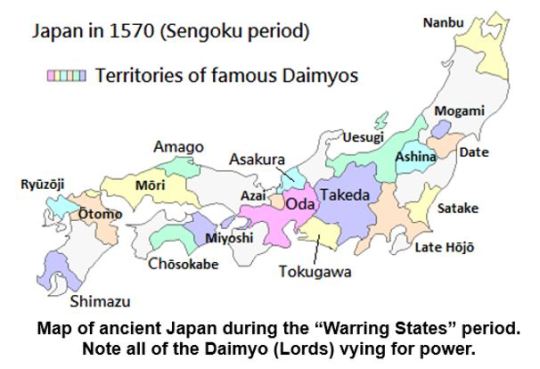
It was during this time that one of these feudal lords rose to power, a man named Tokugawa Ieyasu (first name Ieyasu, last name Tokugawa). Using a combination of political tact, military genius and European steel breast armor, he defeated all other daimyo during the Azuchi–Momoyama period and installed himself as the shogun of the Tokugawa Shogunate. This marked the end of over a thousand years of continuous violence and social turmoil in Japan.
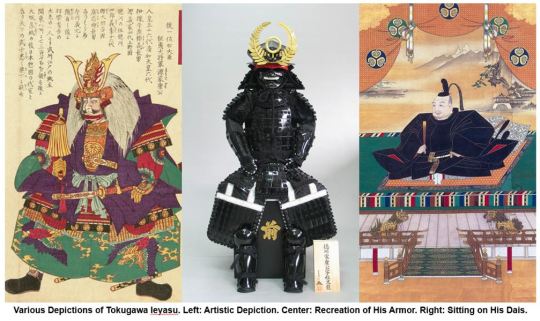
The Tokugawa Shogunate represented Japan’s first unified national government. The country’s existing daimyo were placed under strict control to ensure they did not rebel. The military was nationalized and the existing feudal governments rearranged to ensure centralized control by the Shogun in his capital at Edo. Notably, Edo became modern day Tokyo.
National laws were written, along with cultural and religious standards to ensure social cohesiveness, stability and control. The economies of Japan also flourished, especially in the cities. A consequence of the Tokugawa Shogunate, however, was closing off Japan to the outside world. The Shogun wanted to ensure their rule and control of the populace. Allowing other countries to influence them and provide assistance to competing powers within the country was viewed as destabilizing.
A particularly unique aspect of the Tokugawa’s politic strategy was requiring the daimyos’ families to live in the capital while the daimyo themselves had to go back and forth between their homes in their territory (called a domain) and their homes in the capital every other year. The Shogun essentially held the daimyos’ families hostage to ensure they would not rebel or work against him, although they lived in the comfort and relative freedom of a modern city, not as actual prisoners.

Another tactic the Shogun utilized to quell rebellion was to keep careful control of who entered the city of Edo and its surroundings. Guards were at all entrances and major roads and registries were kept of all people. Essentially, if you weren’t suppose to be somewhere, you weren’t allowed to be there.

Bushdio also developed during this period as way of controlling the warrior class, and was much more complicated than most Western depictions. With war and feudal fighting no longer a constant threat, the samurai class became enforces for the new government. Naturally, the Shogun was particularly interested in controlling them.
Control is a common theme of the Tokugawa Shogun’s government.
The Tokugawa Period was one of peace and stability, prosperity and enjoyment of the arts, but Ieyasu Tokugawa was not a nice person. He hunted down and executed the families of rival clans, including kids, during the takeover. He held families hostage and made sure his subordinates feared him and never stepped out of line. He enacted strict laws to control the populace and made sure no one could challenge him and his government’s reign. And it worked. Japan did not experience another war until the end of the Tokugawa Shogunate 278 years later, when the Emperor regained control and ended the era of isolationism. There’s a reason why modern day Japan doesn’t view this period with derision and loathing; given the context of the time, it was a proud moment for a region racked by warfare and division.
A pattern is beginning to emerge: an island nation ruled by feuding lords with no central power to direct them; a religious and cultural figure with no real power; a period of intense warfare and turmoil followed by a lasting period of unification and prosperity; a powerful central government headed by a hereditary monarch who took power using ruthlessness and military might; a hereditary monarch who rules through fear and demands fealty; a capital city with strict control of who comes and goes.
Themes of control and subordination from a central power.
This is sounds very familiar.
The Military and Political History of the Fire Nation
The history of ancient Japan provides a real-world model for understanding the origins of the Fire Nation’s Imperial Government, the Fire Lord and why they rule through fear and military domination. Keep in mind that the Fire Nation is not Japan, but warfare, centralized control and a desire for peace and stability are universal. Ancient Japan’s experience with feudalism, warfare and the eventual peace that came from having a competent central authority can go a long way in applying Avatar’s “East Asian origins” to the Fire Nation and its villains and heroes.
Using the rise of the Tokugawa Shogunate as a template, the history of the Fire Nation looks like this:
The Fire Islands were ruled by various feudal lords. These feudal lords engaged in warfare with each other as they vied for ever increasing control. Firebending was the primary source of these lords’ military might. The Fire Sages were recognized as spiritual and religious leaders by the Fire Islands people, but they did not have the practical power necessary to enforce peace upon the lands.

At the same time, firebending was recognized as being fundamental to the influence of the Fire Sages and the power of the feudal lords. Since fire can destroy houses, burn fields, melt iron and lay waste to non-bending armies, whoever can control and weaponize firebending for their own purposes will attain the most power. On the other hand, this also makes warfare particularly destructive as even small rebellions could lay waste to cities given how much fire a single firebender can unleash.
At some point, in order to put a stop to the fighting, a central authority came to power, either as one of those warlords or a Fire Sage acquiring enough military and political power. Maybe an avatar helped them. Without a doubt, military might had to have played a role in ending the “Warring States” period of the Fire Islands.
In order to make sure the Fire Islands did not fall back into fighting and remained peaceful and stable, this new central authority created a sweeping national government to control them. Thus are the beginnings of the Fire Lord and Imperial Government.
Because the Fire Nation is full of people with ”desire and will, and the energy and drive to achieve what they want” (in the words of Uncle Iroh), the destructive capacity inherent to a nation full of firebenders must be kept under strict control; if the goal is to create a prosperous, flourishing society, you cannot allow it to be destroyed periodically by walking flamethrowers.

As a result, the Imperial Government is not a “friendly” entity. It controls the nobility and lords who act as the local “vassals” in their home territories; it amasses a large, overwhelming military to quash any attempts at rebellion, and to send a clear message to its people to not even try; it uses fear and threats of violence to control the people who might feel the “drive and willpower” to try their hand at acquiring wealth and power through force.
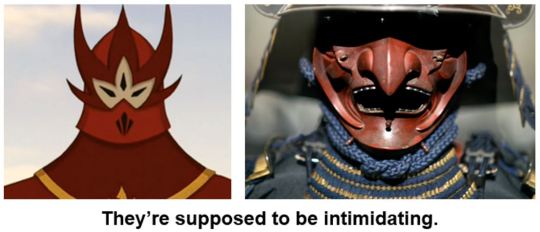
The Agni Kai exists as a means of settling conflict without the destructive consequences of firebending. Perhaps a Fire Lord enacted this to further tamp down on firebenders’ destructive tendencies. It may also be an example of how the Fire Nation’s “warrior class” handles internal disputes in a similar manner as bushido.
Bravery, ferocity and a willingness to fight are valued in the leadership of the country because the Imperial Government is supposed to be a military entity first; how can the Fire Lord, their family and government inspire fear in the people if the people don’t believe they will be crushed if they step out of line?
At the same time, since the Fire Nation is much smaller than the Earth Kingdom, the Fire Lord must ensure they can defend the Fire Nation from invasion; you need a large, devoted, competent military to go up against an enemy multiple times your size.
In order to further control the country, the Fire Lord requires the families of the lords and nobility to live in the closed-off, guarded capital inside the caldera in a similar manner as the Tokugawa Shogunate required. This is why the capital is so guarded and closed-off, yet beautiful and comfortable; it is both a defensive measure for the administrative officials and a means of holding the nobility “hostage”.
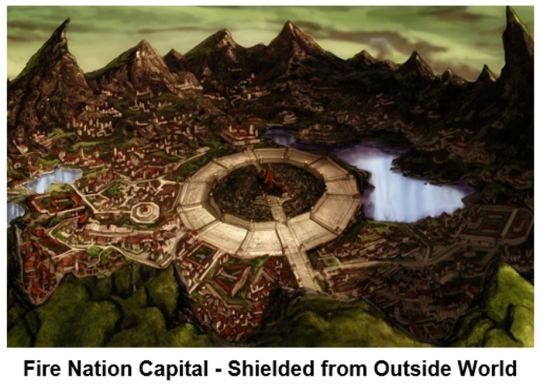
The Fire Lord and Royal Family views themselves as presiding over, and maintaining the peace and stability of the Fire Nation. Their responsibility is to ensure that the peaceful Fire Nation does not fall back into the chaotic Fire Islands. Being nice and democratic is not their means of achieving this; making sure everybody subordinates themselves to the Imperial Government is.
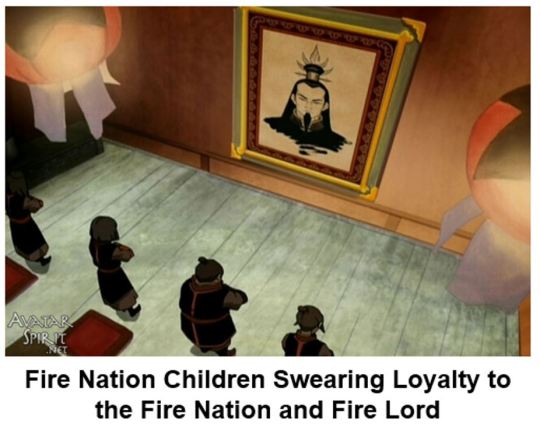
After hundreds of years of peace and an unprecedented era of prosperity, the Fire Nation began to lose its internal enemies. The lords and nobility were under full control. The Imperial Government was vast and efficient. Nobody was trying to invade the Fire Nation. Everyone was happy and proud of their culture and government.
This allowed Sozin to begin looking outward. Using the all-powerful Imperial Government apparatus developed over the centuries, plus the sweeping loyalty to it ingrained into the public, he was able to get the country to go to war against the world. The militarism inherent to the Fire Nation’s leadership was not crafted out of whole cloth but simply cranked up and sent down a dark path.
The military being so willing to go along with it was because of their inherent loyalty to the Imperial Government and their culture of aggression and lust for battle necessary for warriors. This is actually where the 20th century Imperial Japan connections come in, but that’s a separate topic.
In summary, the Fire Lord and Royal Family view themselves as stewards of the peace and order of the Fire Nation. They see their responsibility as doing whatever it takes to prevent the “bad old days” from returning and that the Fire Nation is never weakened by foreign invaders. They rule through coercion and fear in order to ensure a country full of people who can shoot fire out of their hands remain subservient to the Imperial Government’s will. They embrace a culture of fighting because their primary goal is to prevent fighting by deterring those who might want to try.
An Alternate View of the Fire Nation’s Villains
Viewing the Fire Nation’s culture, government and leadership through the lens of Japanese history paints a more coherent picture of the Fire Nation’s villains, versus the M.C. Escher-like theories that result from focusing entirely on mental illness and personality disorders.
Look at it like this: the Fire Lord demands fealty and obedience from the people yet Azula’s emphasis on controlling people through fear is a result of Freudian Excuses and personality disorders?
No way.
Ruling through fear and coercion is necessary from the viewpoint of a soldier-princess who is supposed to command obedience from subjects, or else.
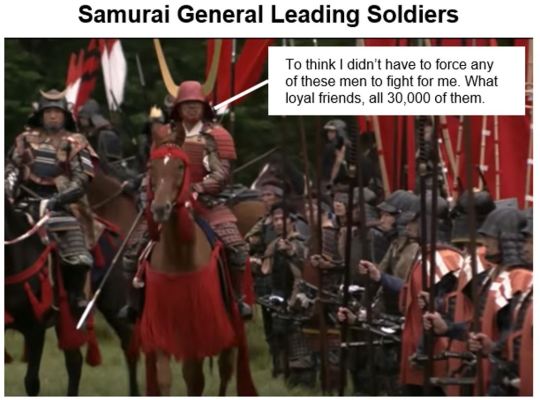
Agni Kais are expected events in Fire Nation culture, so common that child-Zuko is perfectly happy to face the general over mere “disrespect”, but the Fire Lord challenging his son to one is uniquely out of line? It’s awful, I mean, really awful, but it’s not out of line and it says a lot about the ingrained culture of the Fire Nation; Ozai didn’t think it would be viewed as shameful by everyone watching. Keep in mind that the tale of the 47 Ronin started with one member of the nobility insulting the other (essentially) and being asked to commit suicide simply for drawing a weapon inside Edo Castle (strictly forbidden). If Ozai can have his power challenged as any other Fire Lord can, then nobody was willing to oppose him because everyone else supported him.
Iroh spends a lifetime invading the Earth Kingdom, no doubt killing tens of thousands, and he can joke about burning Ba Sing Se to the ground? Of course he can, because it’s what Fire Nation generals do and part of the terrible culture that must be changed, as horrible as it was. The prince-general is supposed to be a military leader and enjoy what he does. He better not be squeamish.
Zuko is expected to be “loved and adored” for having firebending talent, courtly manners (to quote official descriptions of Azula) and intelligence in a similar fashion as his prodigal, early-blooming sister? Yes, because she bloomed early as the type of princess the nobility and leadership want and expect. It’s unfortunate they were so hard on Zuko, but now we know why he wasn’t “adored” like his sister; she was what others wanted Zuko to be.
Ty Lee is strong-armed by Azula into leaving the life she loves, even having her life threatened, when Ty Lee is a family member of the nobility that the Imperial Government seeks to control? Of course she is strong-armed. Can you really imagine this scenario playing out:
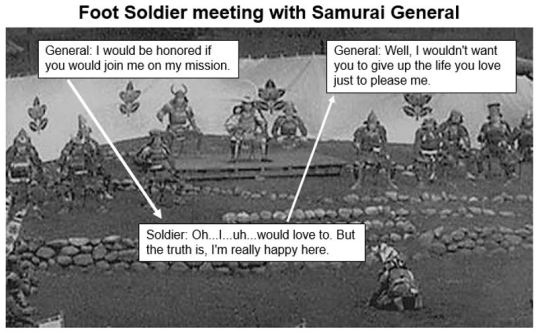
Those lines are taken from the show. Sounds a lot different, doesn’t it? Ignore the smirking and smugness for a moment and think about what is actually happening: a supreme military leader and heir to the throne is bullying a subordinate in order to get what they are entitled to; unwavering loyalty from a subject. Doesn’t make it good. Doesn’t make Ty Lee’s fear and loathing of Azula any less justified, but it puts it in a much more relevant context than vague theories of sadism and personality disorders. It also tells us something about the real ancient world: this how military rulers in East Asia’s history behaved and now you’re getting to see it in a fictional setting.
Fire Lord Azulon orders one of his sons to execute their son? That’s bad. Really bad. Did you also know that Ieyasu Tokugawa ordered his own son to commit suicide over suspicion he was conspiring against him? He didn’t want to but those were the wishes of the lord he was working with to win the war. That’s really bad too, and not shocking for the era, unfortunately. The leaders of the ancient world valued human life a lot less than people do now. It’s sad they didn’t value it more.
Manipulating subordinates (i.e. playing them off each other) and being ruthless were not frowned upon, but legitimate tactics. Murder and backstabbing were useful means of getting rid of an opposing leader. What mattered was winning, and the blood on your hands could simply be washed off, and if people didn’t like you for it? Well, were they in charge?
None of this is “good”. None of this is moral, or righteous, or anything close to how people should act in the modern era. However, these were not kleptocratic dictators like we see around the world today. These were legitimate administrative rulers by their day’s standards, and we (you and me) will never truly know what they were feeling when they woke up in the morning with the responsibilities of warfare and politicking.
We will never be able to completely relate to what these ancient leaders did. Do you know what it’s like to be the law in the land who can order people to commit suicide, and who will do it? Do you know what it’s like to prosecute a political and military war against multiple opponents across a vast country? Do you know what it’s like to manage an ancient authoritarian government after hundreds of years of warfare and chaos? None of us will, but that’s the kind of situation that a fictional country like the Fire Nation can take inspiration from, and should take inspiration from.
These were all very real problems of the ancient world and problems which Avatar, as a fictional work, can allow us to explore in the safety and comfort of not actually having to be there (and without having to open up huge history books).
Summary
The Fire Nation’s political and military history can be modeled on ancient Japan’s, in particular the rise of the Tokugawa Shogunate, where the Fire Lord represents the shogun and the Fire Sages the emperor.
The Fire Nation capital is both the head of the administration and home to the nobility’s families, who are held as hostages (in comfort) to prevent the various lords from rebelling.
The Royal Family and Imperial Government rules through fear and threats of force because they have to keep a country full of walking flamethrowers in line.
As military leaders who can have their power challenged, firebending talent and military prowess are highly valued and necessary for Fire Lords. At the same time, the rest of the country’s leadership wants leaders who appear worthy of that power and authority, hence those who have all the right qualities (Azula) are viewed in higher regard than those who have less (Zuko).
Azula’s emphasis on using “fear to control people” is not a psychological hang-up but a natural tactic of the Fire Lord, military, and Imperial Government to maintain obedience; as a teenager with limited life experience, she has internalized her role as a princess and warrior to the detriment of her personal relationships and emotional maturity (this is where the “child soldier” narrative has relevance).
Ozai represents the pinnacle of self-interest, authoritarianism and militarism that the combination of Sozin’s War and the longstanding nature of the Imperial Government have combined to create. In the ancient world, lords waged warfare for two reasons: to acquire power or pre-emptively wipe out rivals. Ozai wants power.
Ozai challenging Zuko to an Agni Kai is awful but not unusual, hence why he felt he could do it at all. Agni Kais are a fundamental aspect of conflict resolution in the Fire Nation, most likely because the Fire Nation’s leadership values bravery and a willingness to fight very highly. As Zuko was a prince and future leader of the warrior class, those values applied to him as well, but they got applied to him far too young (again, this is where the “child soldier” narrative has relevance).
And finally, by modeling the motivations of the Fire Nation’s villains and heroes on the military leaders of ancient Japan, you have the opportunity to learn about and critique that ancient society while also giving it a fictional flare.
As a final remark on applying the history of ancient Japan to the Fire Nation, the Tokugawa Shogunate ended when the Emperor forcibly took control of the Tokugawa government in order to end the forced isolationism. If ancient Japan hadn’t been pressured to adapt to more advanced European civilizations (say, if it existed in a vacuum) then the Tokugawa Shogunate might have continued to be the longest and most stable period in Japanese history; post-World War 2 Japan is only 70 years old while the Tokugawa Shogunate lasted for 278. When the Emperor wrested control of the country from the Shogunate, there was already enough peace, stability and government bureaucracy in place to lead a rapid transition of the country into modernity. That was the ultimate value of the Tokugawa Shogunate.
If the Fire Islands had not unified under a central authority, then they might have never industrialized so rapidly during that “unprecedented time of peace and prosperity” and may have eventually been conquered by the Earth Kingdom (should an EK conqueror have found a way of killing the Avatar, or taking advantage of their absence).
Conclusion
Think about ancient Japan for a moment. All of the warring lords. The conquest and ruthless political maneuvering. The ruling through fear and totalitarian control. What is a more reasonable explanation for the behavior of that society: mental illness and personality disorders, or universal concepts of ancient nation-building?
What makes more sense for furthering Avatar’s East Asian themes in terms of the Fire Nation: sociopathy, personality disorders, lack of fundamental human qualities, petty bullies and insecure abusers? Or universal concepts of ancient nation-building in the context of people who can shoot fire out of their hands?
Was Ieyasu Tokugawa suffering from a personality disorder? Was ancient Japan swimming with people who lacked fundamental human traits? That would be and absolutely extraordinary anomaly of human genetic variation.
When discussing the evils of the Fire Nation, you have to start with the in-world context that created them, and in order to understand that context, you have to apply some East Asian history. Why “decent” or “normal” people end up doing terrible things is a question as old as humanity itself and should not be erased from Avatar.
In order to understand why Ozai and Azula seem like “bad” people to us, it’s because the rulers of ancient Japan acted like bad people. Zuko can’t be soft and fumbling. Azula can’t let people say no to her. Iroh can’t abandon the siege with no consequences. Ozai can’t let Zuko refuse to fight. As bad as many of these things are, they are driven by the fact these people are the most powerful entities in their country and must show their fire-wielding subordinates that they deserve their power and should not be challenged. There is no room for weakness, only strength and competence.
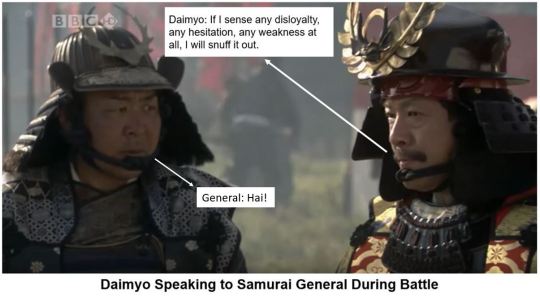
When you resort to psychological theories or genetic anomalies to explain the Fire Nation’s villains, you erase the opportunities to tie the Fire Nation to critical elements of East Asian history, namely the rise and success of the Tokugawa Shogunate. By relating the main villains of Avatar to the very real “villains” of the ancient world, you preserve the East Asian themes that make Avatar unique and informative to a Western audience and help shed light on what drove them to be what they were.
1K notes
·
View notes
Text
Look upon my Works, ye Mighty: The Colossus of Garfield

Fig. 1
Surely our readers will need no introduction to The Colossus of Garfield, tenth wonder of the world. A much-favored subject of Art, Poetry, and History, the Colossus continues to preoccupy our collective imagination, as it captivated the artists who hewed his hulking body from the mighty pliant rock. Babel-like, he looms as testament, monument, and warning— for the Colossus is the folly of a long-since fallen empire, attempting to immortalize their king— and yet, how his image immortally endures!
Historians place the construction of the Colossus variably, but without a doubt before our millennium. The earliest historical references to the Colossus are roughly contemporary with ancient California. For centuries upon centuries, he has been a site of pilgrimage and tourism, similar to the (likely fictitious) ruins of the Colosseum (Fig. 2) as described by authors in the ancient world, which drew thousands of visitors curious to witness an immense historical object. The Colossus is one of the largest and most magnificent ruins standing today, and unlike the Colosseum, there is no doubt about whether it really existed.
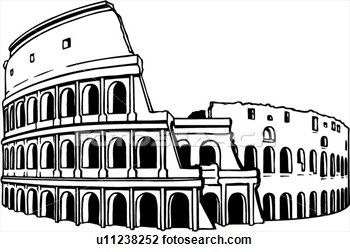
Fig. 2 [ Artist’s reconstruction of the apocryphal Colosseum ]
Today, there are many historical depictions of the Colossus of Garfield, all worthy of examination, and it is our hope that whether you come to our little book as a scholar of the Colossus or as a reader who knows him only as the tenth wonder that you will find something of note or amusement here.
Let us return to Fig. 1:

In this oil on canvas painting of the Colossus, by an unknown artist in the 17th—18th century WX, little room is left for the sky. The Colossus and the vast plain of the rocky beach upon which he sits are the overwhelming focus, massive waves breaking upon his placid visage, walls of foam several feet in height building up around his immovable bulk. Bleached by sun, sea, and storm, the Colossus basks unperturbed. In the background, indistinct buildings larger than one might easily comprehend rise upon the sea cliffs, works of the mighty empire following the collapse of that which crafted the Colossus.
The painting evokes a distorted sense of time and a distorted sense of scale, juxtaposing old and new, centering the Colossus despite its weatheredness, and even taking particular care to render that weatheredness with something like love. New climate data has determined that the seas were already receding significantly in the 17th century WX, suggesting that the artist, having visited the Colossus, wanted to reach back into time to when the sea had broken daily upon its monumental little paws. It was a time long ago— a time when the Colossus was already ancient.

Fig. 3
In Fig. 3, we see another stunning oil painting of the Colossus by another unknown artist, probably dating from the First Modern Desert Age, though the possibility of the artist depicting an earlier time, like the painter of Fig. 1, cannot be discounted. Likely painted during the 2nd century RYE, here the Colossus sits among endless dunes. The desert takes on a naturalistic, bluish hue in contrast to the garish orange of the Colossus, somehow scarcely diminished by hundreds of years. The Colossus appears to offer some shade, but the unseen overhead sun fills the canvas with a palpable heat.
Art historians throughout the centuries have disagreed as to whether the Colossus was originally built to stand at the sea’s edge, in the water, or on dry land, and who can blame them? The effect of the Colossus remains transformative regardless of where it sits. Perhaps its builders even knew that the Colossus would endure longer than the sea or sand upon which it originally was hewn into the shape it continues to hold today.

Fig. 4
Fig. 4 is an oil and acrylic painting which likely drew upon the Desert Colossus (Fig. 3) for its composition. Probably dating from the 9th century RYE, the artist portrays a partially submerged Colossus in much the same style as the Desert Colossus, with influence also taken from the Sea Colossus (Fig. 1). Here the focus is on the shallow seas surrounding the Colossus nearly as much as on the Colossus itself, following the lead of the Desert Colossus. A sense of barrenness pervades the Submerged Colossus, no living things visible within the frame. The Desert Colossus by contrast is suggestive of perhaps some vegetation, perhaps some fungus, while the Submerged Colossus emphasizes a true sense of loneliness: the observer is alone with him.

Fig. 5
In this engraving, from the Second Modern Desert Age, by the anonymous historian and physician known as The Anonymous Historian and Physician of the Second Modern Desert Age, we see documentation of how the eyes of the Colossus were mined for old materials for use in weaponry in the Fourth War. When the seas around the Colossus receded yet again, this time leaving behind a rocky bed, it became a simple matter to access the Colossus. Clearly, the urgency of the Fourth War took priority over preserving what was left of the Colossus’ original state. Decorative parts of the Colossus which can be seen in previous depictions are missing here, likely also mined for old materials.
However, the Colossus certainly survived the Fourth War, and still remains standing after the Seventh War, his expression scarcely altered by the loss of his eyes. Perhaps it would have even brought his creators some pleasure to know that the Colossus played a role in wars so long after their deaths.
For the Colossus must depict a Soldier Emperor, some have cried— a man in the form of an unknown beast, prepared to pounce. Others have argued that the Colossus is at rest, that nothing about his posture indicates a thirst for battle. Indeed, the Colossus cannot even be said definitively to represent a man, though the rulers he is believed to possibly depict are largely men.
We have seen the Colossus itself throughout time. But just who or what is the Colossus? The question has vexed scholars for nearly as long as the Colossus has stood. We call him “Garfield” because some ancient texts do, not because we have any idea who this “Garfield” was or what he meant to his people.

Fig. 6
Another tremendous monument which still stands today is that of the Sphinx, sometimes informally referred to as the Garfield by scholars of the Colossus (though this is an error, as the Sphinx pre-dates the Colossus by at least a century). In Fig. 6, we see a tempera painting of the Sphinx in which its similarity to the Colossus is undeniable. Could the creators of the Colossus have been imitating the Sphinx? The Sphinx is believed to be a representation of a ruler as a mythological being or a God, and perhaps the Colossus is similar.

Fig. 7
But what if the Colossus is meant to represent an animal? The animal is unidentifiable, and likely to be mythological in nature, though it may be a stylized depiction of a living animal. Scholars have debated endlessly which animal the Colossus might depict, with recent arguments being made for the Colossus perhaps depicting a member of the same or a related species to the unidentified animal seen in Fig. 7, a “photograph” from the 20th or 21st century AD, when the art of photography flourished briefly before being lost and the famed photographer Leonardo da Vinci captured this image.

Fig. 8
And if we turn to other ancient art? Believed to also be a portrait of “Garfield” (which is to say, the person or animal portrayed by the Colossus), dating from a similar timeframe as the Colossus, Fig. 8 is likely a funerary inscription. Here, the figure depicted is a sort of guardian, perhaps looking over the deceased.

Fig. 9
Another piece of ancient art, Fig. 9 was created by an artist known only as “MarkVomit” and has been the subject of much debate. Is it meant to reaffirm Garfield’s power, to remind the viewer that they are not immune to his propaganda? Or is it meant to protest Garfield, to subvert and challenge the propaganda that this ruler must have utilized to maintain his rule? The answers are lost to history.

Fig. 10

Fig. 11

Fig. 12
Other sculptures appearing to depict the same figure exist, though none on such a monumental scale as the Colossus. A frequent theme seems to be his ability to control time, as seen in Figures 10–12. Was this what inspired the creators of the Colossus to build him so enduringly?

Fig. 14
One of the more outlandish theories regarding his nature is that the Colossus is meant to resemble a cat (see Fig. 14 for a hyperrealistic painting of a cat for reference) but this has largely been discredited by modern scholarship. If the Colossus is a feline, certainly his species is different— simply observe the difference in ear shape, eye shape, and gait. However, certain cats do carry a gravitas reminiscent of the Colossus, which brings the question again to mind— could the Colossus have been an ordinary domestic shorthair all along?
The identity of Garfield, if there is a historical “Garfield,” remains a tantalizing mystery. Here we have such a tangible piece of history, and we are so unable to comprehend him! In another sense, though, perhaps the Colossus has taken on its own significance, and may represent something far beyond the man he once symbolized, the God he was built to honor, or the animal he commemorated. For who in our modern world has not gone to see the Colossus and found themselves moved? His place as the tenth wonder is well deserved.
Perhaps new understandings will come to light regarding the nature of the Colossus, and perhaps not. Either way, he will remain until he is entirely unmade, his old materials bit by bit chipped away by the hands of humans and humidity fluctuations, the silent and sole guardian of his secret knowledge.
In closing, let us visit two pieces of poetry composed about the Colossus of Garfield (the first of which only survives in this single fragment).
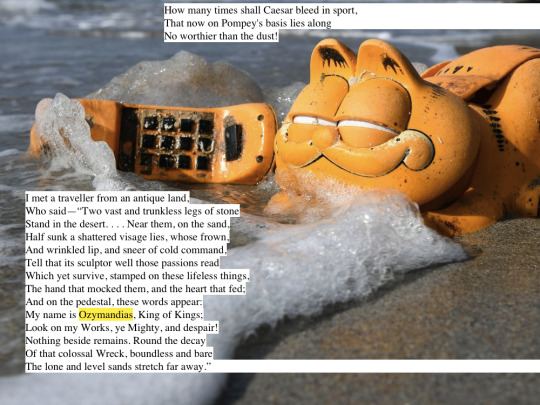
242 notes
·
View notes
Text
Greek Culture and Why It’s Essential to Better Understanding the Greek Gods (Examining Pan as an Example)
Everyone knows the Greek gods are Greek, but what does that mean to us? I think that understanding the culture around the Greek gods is extremely helpful for understanding them better and I’d like to use the Greek god Pan as an example to illustrate just how important I think this is. Greek culture (both ancient and modern) is just as interesting and worth studying too, which is another reason I wanted to talk about it.
A quick note: The ancient word was incredibly diverse and covered a long period of time. Even between cities practices, myths, and views could be very different, so it is important to point out that there is no “one way” to see most things, even though there are some general things people do agree on. Even the genealogy of gods sometimes varied depending on location and gods themselves could be understood differently across Greece both in location and time (1, 2, 3, 4). Myths were often stories made to be entertaining, not to accurately and completely reflect how gods were seen in a religious sense, so the view of a god that a myth and religious text portrayed were often different. For some deities, understanding Greek culture better may make the difference between a loose group of unrelated domains vs a constellation of domains that paint a bigger, more cohesive picture of how they were viewed, like how something may be greater than the sum of its parts. This is how I think of Pan and his domains. Of course, it is also important to note that Pan is extremely complex, and this post is not meant to be comprehensive, just informative. With that said, let’s talk about the goat god Pan and Greek culture.
Why Pan? Well, unlike many gods whose origins lay in mythical places, Pan’s origin is Arcadia, a region in the south of Greece (this region has changed since ancient times, but it remains as its own region) (1, 2, 5, 6, 7, 8, 9) . Why does this matter? Because Pan was viewed as an Arcadian (god); even in Thebes and in Athens worshipers connected Pan to this region (1, 2, 4, 9, 10, 11). In other words, how the Greeks viewed Arcadia as a region and culture influenced how they viewed and understood Pan.
Then first, we should ask, what is Arcadia?

(credit: https://en.wikipedia.org/wiki/Arcadia)
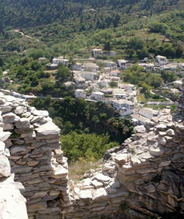
(source: 12)
Arcadia (Αρκαδία) is a mountainous region in the Peloponnese whose capital is Tripoli (Τρίπολη ) (12). In ancient times it was seen as a place of harsh wilderness (forests, plains, glens) where most people were shepherds (1, 5). It was “out of the way”, “hard to reach”, even viewed as “spooky” (5) and “uncivilized” (1, 13). This is related to many, if not all of Pan’s domains. In fact, Pan was known as the “ruler of Arcadia” (1, 5, 13) and it was even said that,
“The region was sometimes called Panland - in Greek, Pania. Pan was as rough as the country, half goat, half god…” (5)
Arcadia is the earliest center of Pan’s worship and it was done in formal sanctuaries (1,2, 14). After the Battle of Marathon in 490 BCE, Pan’s worship spread more widely to the rest of the Greek world (1, 6, 9). After this many people (in Thebes and Athens for example) worshiped Pan in grottos or caves (1, 2, 4, 10, 11). This difference actually reflects how people in those places connected Pan and Arcadia; for them, a cave or grotto was a wild place, like Arcadia, and since they had few other “wild” spaces this space kept Pan and his connection to the natural world within their worship. A scholar on Pan noted that “his lodging (in a cave at the Acropolis) marks him as connected to origins”(1) and others have pointed out this as well (10, 11) . This makes it clear that this cultural connection was important for how they worshiped and thought of Pan.
The first example: Pan’s relation to music? That was related to Pan being Arcadian;
“The simple, moving music of the shepherds (from Arcadia) gained a wide appreciation over all the Greek world. In time, this pastoral … music began to inspire highly educated poets …” (13)
“The one quality that softened the brutishness of Arcadian life was music, whether performed by the goatherds or played by Pan”(13).
Music is a fundamental part of Pan and he has been called: “a lover of merry noise” (Homeric Hymn to Pan) “a most accomplished dancer, a god of noise and movement, beautiful dancer”, and a “lord of the dances of the gods” (1). Just as music was a big part of other Greeks viewed Arcadia, it was a big part of how people saw Pan; Pan was even said to have created the panpipes and music was an essential part of his cult (1, 14, 15). In fact, the idea that Pan could manifest as music and in natural sounds was popular at times (9, 11). This isn’t to say music was unique to Pan (it wasn’t) or that music was not used to worship other deities (it was) but that music was an essential part of how ancients understood Pan, so we should be aware of that and the potential significance it has.
Music was an essential part of Greek and Arcadian education, even according to Plato and Socrates (1, 16). While I do not study the classics, I do think that Pan’s connection to music is symbolic of something more than just “pretty sounds” although I do not feel confident enough in my understanding to make any specific connections to his other domains or aspects. Music was essential to the ancient Greeks and was thought to be important for character / personal development, it was thought to deeply affect the soul and I think this is also reflected in Epidaurus’ hymn to Pan;
“The Epidaurus Hymn reminds us that Pan's music and dance restore a threatened cohesion. Dance, laughter, and noise become, in the festival, signs of a recovered closeness (1).” (cohension was threatened by a recent war)
Just as music was thought to affect people deeply, Pan also was associated with panic and mania (related to possession), which similarly has a strong affect on people spiritually and emotionally (1). If I were to make any connections between his musical domain and another domain, I would say that Pan’s domain of music seems connected to his domain of nature since his style of dance was called “animalistic”, he was called a “leaper” and for the fact that he was believed to be able to manifest himself in natural sounds, like was mentioned before (1, 9, 11).
A second example: Pan’s nature as a goat/shepherd and a god of fertility is reflective of Arcadia’s reliance on shepherding to sustain life: Pan has been called “divine-he-goat-shepherd”, “indispensable patron of fertility...” and “keeper and protector of the flocks” (1). Pan was a very positive figure because he was thought to help sustain life itself; as one scholar points out, Arcadia is “first and foremost a land fit for herding.” (1). One noticeably unique thing about Pan compared to the other Greek gods is how he is part goat. Interestingly, Pan was first depicted as a he-goat standing upright, not as a satyr and it seems that Pan was only depicted as a satyr (at least widely) after his cult left Arcadia (1, 17). If one was not aware of how central goats were to Greek (especially Arcadian) society then this may seem random or superficial, but it clearly is not.
Pan was a fertility god, but this domain is concerned with more than just lust and sex (even though these were important aspects of Pan) but also abundance both sexual and platonic; for example, the birth of twin goats (as opposed to a single goat) was attributed to Pan (1). Another example of this connection between sex and (platonic/ nonsexual) abundance is the description of the meaning of a dream where Pan and the dreamer have sex written by Atermidorus in his Interpretation of Dreams in the 2nd century CE:
“If he (Pan) gives someone something or has sexual intercourse with someone, it fortells great profit, especially if he does not weigh that person down” (18)
This theme of abundance and goats/fertility is related to Pan’s domain of rustic music as well: In a hymn found in the Palentine Anthology, a resource that showed the traditions of herdsmen and shepherds, one poem asks for Pan to play his pipes so that the she-goats might give them lots of milk;
“The poet here attributes to the god's music a power elsewhere expressed in the image of a sexual union with animals. The "divine message" (or "sacred voice": hieron phatin) of the syrinx brings about an abundance of milk. (1)”
Pan’s domain of shepherding/goats is also related to his role as a god of hunting. Unlike Artemis, Pan’s domain of hunting was only concerned with the type of hunting shepherds would do, that is, hunting small game and hunting to protect the flock (1). Goats were also associated with hunting because mountain goats were hunted for sport (1). In fact, “Arcadians thought Pan responsible for the abundance, and correspondingly for the scarcity, of meat, whether obtained by hunting or by herding” (1). Without understanding this distinction someone might mistakenly think Pan and Artemis were interchangeable in hunting.
Because we see such a concrete connection here drawn by an ancient Greek, Atermidorus, I think it is more than reasonable to say that the fertility domain was also connected to abundance more generally. Another example is in the story of how Artemis visited Pan in Arcadia and he gifted her hounds which he had bred himself (15, 19). Despite the mention of how the dogs had recently given birth, in this story Pan is “devoid of eroticism”, which further supports this connection between fertility and nonsexual abundance (19.). The hounds represent the fertility aspect of Pan (they recently gave birth) and platonic/non-sexual abundance (Pan gifted them to Artemis and as the author notes, the story is “devoid of eroticism”). Hunting (done by shepherds, associated with Pan) also served to protect the flock, protecting this abundance (1).
Conclusion: Without the context of Arcadia as Pan’s origin, it is hard to have as deep an understanding of him, which I think shows us why culture is also important to learn about. Without this context people may misunderstand Pan’s domains of fertility/shepherding, hunting music, and nature as disconnected or random, however by understanding Pan’s cultural context (Arcadia / Greece) a clearer and more meaningful image can be seen. These elements are closely related and interrelated, which I think is important because seeing these domains as “somewhat connected” is significantly different than seeing them as “interconnected”.
Here’s a table to summarize what I think we can better understand about Pan with this knowledge:

A disclaimer: This isn’t meant to be all encompassing as Pan is an extremely complex god. I have only focused on the way Pan was viewed by some ancient Greeks, more was written about Pan later. Pan also was not simply a “positive”, or “friendly” god, he was also perceived as terrifying and that aspect of Pan shouldn’t be forgotten or underappreciated. This post was designed to show how important culture is and so I have focused on aspects of Pan that help us see this clearly. That said, I do feel I have touched on most of Pan’s major domains (fertility/shepherding/goats, hunting, music/dance, nature, and panic). I have tried to give a better sense of Pan using context, not take anything out of context, so if you think I have made a mistake or misunderstood anything then please let me know. I am not a classics student, so there is a chance I misinterpreted something along the way. This post serves two purposes: to demonstrate how Greek culture is important for understanding the Greek gods and to shed some more detailed light onto Pan (which requires the first bit). I also do not think everyone interested in Greek gods or mythology needs to write long posts like these, I just want to emphasize that thinking holistically is important. We should just be aware of how everything is interconnected and be open to learning more about different things that can help improve our understanding.
Citations:
1 : Borgeaud, P., & Atlass, K. (1988). The cult of Pan in ancient Greece (p. 58). Chicago: University of Chicago Press. ISBN 13: 9780226065953
2: Ogden, D. (Ed.). (2010). A companion to Greek religion. John Wiley & Sons.
3: Zolotnikova, O. A. (2017). Becoming Classical Artemis: A Glimpse at the Evolution of the Goddess as Traced in Ancient Arcadia. Journal of Arts and Humanities, 6(5), 08-20. Doi: 10.18533/journal.v6i4.1157
4: David Gilman Romano, & Mary E. Voyatzis. (2014). Mt. Lykaion Excavation and Survey Project, Part 1: The Upper Sanctuary. Hesperia: The Journal of the American School of Classical Studies at Athens, 83(4), 569-652. doi:10.2972/hesperia.83.4.0569 doi: 10.2972/hesperia.83.4.0569
5: WILLS, G. (1998). The Real Arcadia. The American Scholar, 67(3), 15-27. Retrieved May 31, 2020, from www.jstor.org/stable/41212784
6: GARTZIOU-TATTI, A. (2013). GODS, HEROES, AND THE BATTLE OF MARATHON. Bulletin of the Institute of Classical Studies. Supplement, (124), 91-110. Retrieved May 31, 2020, from www.jstor.org/stable/44216258
7: Yioutsos, N. P. (2014). Pan Rituals of Ancient Greece: a multi-Sensory Body Experience. In Archaeoacoustıcs: The Archaeology of Sound, Publication of the 2014 Conference in Malta (Vol. 57).
8: Parker, R. (2011). Analyzing Greek Gods. In On Greek Religion (pp. 64-102). Ithaca; London: Cornell University Press. doi:10.7591/j.ctt7zgrm.7
9: Haldane, J. (1968). Pindar and Pan: Frs. 95-100 Snell. Phoenix, 22(1), 18-31. doi:10.2307/1087034
10: Yioutsos, N., Kamaris, G., Kaleris, K., Papadakos, C., & Mourjopoulos, J. (2018). Archaeoacoustic Research on Caves dedicated to Pan and the Nymphs in Attica, Greece.
11: Yioutsos NP. (2019) Pan Rituals of Ancient Greece Revisited. In: Büster L., Warmenbol E., Mlekuž D. (eds) Between Worlds. Springer, Cham. Doi: 10.1007/978-3-319-99022-4_7
12: Arcadia. The Editors of Encyclopaedia Britannica - https://www.britannica.com/place/Arcadia-region-Greece
13: Ruff, A. (2015). The Classical Origins of Arcadia. In Arcadian Visions: Pastoral Influences on Poetry, Painting and the Design of Landscape (pp. 1-14). Oxbow Books. Retrieved May 31, 2020, from www.jstor.org/stable/j.ctt19704rw.5 , eISBN: 978-1-909686-69-4
14: Yioutsos, N. P. (2014). Pan Rituals of Ancient Greece: a Multi-Sensory Body Experience. In Archaeoacoustıcs: The Archaeology of Sound, Publication of the 2014 Conference in Malta (Vol. 57).
15: Rinkevich, T. E. (1973). Comic structure in Theocritus 1-7 (Doctoral dissertation, The Ohio State University).
16: Stamou, L. (2002). Plato and Aristotle on music and music education: Lessons from ancient Greece. International Journal of Music Education, (1), 3-16.
17: Campbell, G. L. (Ed.). (2014). The Oxford handbook of animals in classical thought and life. Oxford Handbooks. DOI: 10.1093/oxfordhb/9780199589425.001.0001 , ISBN: 9780199589425
18: Stewart, C. (2002). Erotic Dreams and Nightmares from Antiquity to the Present. The Journal of the Royal Anthropological Institute, 8(2), 279-309. Retrieved May 31, 2020, from www.jstor.org/stable/3134476
19: Faulkner, A. (2013). Et in Arcadia Diana: An Encounter with Pan in Callimachus’ Hymn to Artemis. Classical Philology, 108(3), 223-234. doi:10.1086/672004
Homeric Hymn to Pan: http://www.perseus.tufts.edu/hopper/text?doc=Perseus%3Atext%3A1999.01.0138%3Ahymn%3D19
#pan#pandeity#greek gods#Greek Mythology#Ancient Greek Religion#hellenic gods#Hellenic pantheon#I hope you all find this helpful!#hint: if you go to sci-hub dot tw you can copy/past the doi to get the paper for free! It's a super helpful resource!#feel free to send me asks and I can try to find you papers on stuff that youre looking for : )#sorry the table is blurry#I tried to fix that but yeah
304 notes
·
View notes
Text
Top 20 2021
My Favorites (updated)
Hello my readers, it’s been a while since I just posted something not related to a headcanon and I am doing one right now. I just wanted to take a bit of a break to just get SOMETHING on here on my days off work. Plus I’m just trying to find my groove when it comes to writing again so hopefully this helps me just get back into the mood of making a post more often lol. I wanted to revisit this topic for a while just because we’ve had a lot more events and a lot more alts in the game were added. And I know for a fact LifeWonders reads these posts in some capacity because I have meme’d an AR into the game with my top picks from the last list I did for Christmas 2019. No I didn’t. I’m just joking around and I know LifeWonders doesn’t read this.
Anyways rather than just make up a list on the spot like last year I decided to use the Housamo Sortmaker (Link: https://club.housamo.xyz/sortmaker/ ) to try and make a list that’s more revealing to what I was thinking at the time. Since I talked about 20 characters ish last time I’m just gonna read from my 20th place to my 1st place spots and try to justify whatever I was thinking at the time. Anyways-
20: Marchosias and Susan: This one was a surprise for me if I’m being honest but I’m just gonna blame the fact on Shukou’s recent involvement with LifeWonders in the form of Live A Hero and how Ryekie and Mokdai live in my headspace rent free whenever I think about the characters in that game. Maybe we can see about getting some LAH headcanons since that’s a LifeWonders property too). So out of all the characters Shukou drew for Housamo why did I pick Marchosias? Easy, it’s been 4 years and this poor man has yet to receive a proper alt or any kind of skin for that matter and I think that it’s a crime. Sure he’s not my favorite but he’s definitely grown on me because he’s just a gentle dad kind of character and his design has grown on me over the years. I just hope he doesn’t get left behind since he has a lot of really interesting and potential things to look forward to in the future given how the main story has unfolded.
19: Shiva/Algernon: The helmet heads are together because DAI XT quickly became my favorite artist for Fire Emblem Heroes and I really just like their designs. DAI XT just knows how to draw robots, armor and muscles well. Also Chapter 11 with Shiva you can read into some interesting perspectives. I don’t want to spoil any of the untranslated content for anyone who’s waiting for the official english translation. But if you are curious Roureem has a blogspot where he posts summaries of the newly released events.
Link: https://housamosummaries.blogspot.com/
18: Cthugha: I love this goober so much. He’d constantly try to act super sentai just trying say good morning everyday. He may not be very bright but that just adds to his charm and honestly I enjoy how he always tries to play the hero in a lot of scenarios because it’s refreshing when they implement him after a bunch of heavy hitting story stuff. I’m not gonna spoil too much about it but I will say he’s more than welcome after everything Chapter 10 and 11 put the reader through.
17: Mineaki: I’ve made a post about him being one of my least favorites way back when I first started this blog and let me just say how times have changed and I’ve learned the value of not judging a book by it’s cover. I still think there’s something a bit off about Kowmei’s style for his characters, but Mineaki has definitely grown on me. He’s a caring instructor who does watch out for his students even if it’s not always in the most direct way possible. Not to get into too many spoilers he’s got a lot of intrigue around him as well and I am curious to see his role get expanded down the line.
16: Ded: Housamo is the reason I really like christmas. The Christmas stories despite following a similar structure to each other do tend to be my favorite stories. Ded himself is also just another good dad character. He’s also two guys for the price of one, so I mean… you know… you’ve got the forever ask your other dad situation. There wasn’t much thought put into this choice I just like santa as a concept because I think the outfits are cute, it’s always nice to get something for people you care about on Christmas and Ded is the perfect embodiment of both sides to Christmas.
15: Shinya: Everyone we need to manifest buff Shinya for 2021, this is not a drill. This is legitimate. We must make Taromati’s and my wish come true. To be more serious again he’s just a sweet and gentle character. He’s also drawn by my favorite Housamo artist. Their characters always just look so naturally good. I’m just surprised he hasn’t gotten much of an alt given he’s perfect material for Valentine’s day. He’s just a soft boy and I would love for him to be in more things because I just enjoy seeing him.
14: Jacob: I have to be honest Jacob is on here because every time I look at him he just gets more handsome to me. I wasn’t all that impressed with his introduction and we don’t know much about his background but I’ve just been drawn to him more and more. Maybe it’s just because he’s drawn by GomTang? I just like looking at him and I can’t help it. To speak a bit less crass he’s another gentleman kind of guy and those are always nice.
13: Shennong: Yeah I like the doc a lot. Firstly, I’m a huge sucker for big bulls and Shennong fits the bill. The white fur really adds to his appeal visually and the purple horns give off a bit of an unnatural appearance. Shen feels like someone who’s been touch starved and alone for a long time given how he acts as a character and when we actually hug him I just lost it. He always has others well being on his mind so he’s not afraid to jump in and help, or give a much needed lecture about when you need to take better care of yourself. He just comes across as very well balanced overall.
12: Heracles: I won’t lie- at first he didn’t interest me much. He looked incredibly plain when among the rest of the cast and he seemed like the typical “bait” character since the banner had Echo, Barguest, Gyumao and Snow. But after reading the translation for Valentine Time Slip I was taken aback at how much of a gentle giant he turned out to be and I just really liked his interactions with the others in that event. And honestly his special quest from that year was one of the more unique ones given the slower pace and more romantic vibe it had. After the event warmed my heart I did a complete 180 and I just knew I really liked him.
11. Yasuyori: Before I start praising him I feel I have to justify why he didn’t quite make top 10 and it will have some mild Chapter 10 spoilers. To be as vague as possible his resolution just didn’t vibe with me at the end of Chapter 10. Like it wasn’t a bad resolution and it was the right choice to make but in my opinion there really wasn’t a moment I felt was clear where he made a choice for himself. Everything just sort of happened around him and it felt like he didn’t really do much to improve his situation. To an extent I kind of see that being the idea given his origins and the story he’s based on and there is some semblance of him coming to terms with himself alongside his isolation being portrayed pretty well, but I just wasn’t satisfied with it as much as I would like to be. With that out of the way, oh my god I just want this boy to never stop smiling and I just want to give him hugs constantly please he just deserves to be happy!!! Yasuyori is a character who’s got a lot of baggage and he’s just trying to find ways to properly cope with his trauma and not repeat past mistakes and I just really like that idea. His role in Xmas 2020 (sorry I just forgot the name of that event, but its when he gets his alt) was a much better representation for his character in my eyes. I’m not gonna spoil anything like I keep saying but he isn’t one to disappoint in future appearances and I just hope this lovable lug keeps getting the support he deserves.
10: Hephaestus: A spicy way to start the latter half of the list. I just want to give this lad a hug and tell him he is worthy of love. But at the same time he is a little shit… and I love that. I can’t fully explain why I grow a paternal instinct in me seeing this grown man sob about his mother but I just do. I want to keep him safe and give him all the affection he wants. Though I am aware a lot of Hephaestus’s interest in his parental figure is… questionable. I am just gonna say I would accept his love for what it is and he just wants approval.
9. Shuten: I’ll be honest I have no proper reason for why I like Shuten so much. He’s just a cool and reliable guy. He just seems like a go with the flow kind of person most of the time and he’s a bit more direct than most of the characters which I always appreciate. Plus I have an unspoken bias for naop guys in Housamo.
8. Durga: While not number 1 on this list, I still really like Durga. She’s quirky but not to an annoying degree, she’s determined and definitely very confident in her own abilities. Her growing to be more sociable throughout her events is something I enjoy seeing because it really creates this sense of growth.
7. Kyuma: I get a lot of people don’t like Kowmei’s art but I really think we should look past it because Kyuma is one of the sweeter picks. He’s someone who just wants to prove himself for his own worth and not what David can provide, but David is part of him and it just creates the potential for a good arc. Plus this boy is unintentionally smooth and will just take your heart when possible. I honestly want to see Kyuma more in events because he’s honestly the jock that carries 3 of the 4 brain cells. He’s also the last one without an alt so I’m just hoping he gets one in 2021 because he really deserves one in my opinion. (Also fan art makes him really cute).
6. Tomte: Tomte is relatively new but honestly his event in 2019 really endeared me to him. I’m trying to be spoiler free because the best way to enjoy these stories is for yourselves but let me just say his arc in the event was really endearing to me and much more than I was expecting. His fan service is also incredibly hammy and I love it. Visually Tomte is one of my favorites, I love his multi colored hair and starlit pupils cuz it makes his otherwise more generic look have some flare. I knew I liked him out the box and when I read about him in the summaries and can’t wait to read the official translation for him. I was just very endeared.
5. Tetsuya: Tetsuya fucks. Moving on…
Jokes aside this one’s a bit simple. I have no shame in admitting I think he’s attractive and his whole resistance towards wanting a relationship is cute in a weird roundabout way. When he says no I just want it MORE. I just really like duo haired tsunderes.
4. Kengo: Kengo 3rd alt 2021. Please LifeWonders I need my favorite Summoner. He’s a bro and that’s what counts. Kengo has got your back, not afraid to rely on you, a very fun and dynamic guy. Sure he’s not that bright when it comes to making plans or any book smart, but there are times where he’s the best at being able to read the room or just understand what someone needs to hear even if it isn’t always what someone wants to hear. His bullheaded nature is actually one of his redeeming qualities because it’s nice to just not overcomplicate things and just understand what’s actually going on. Yes the early story didn’t do many favors for him but to me the events, especially the later ones, do much more work for his character. To me, at least.
3. Ashigara: Ashigara is best bear, and I will defend that stance in 2021. The main thing that draws me to Ashigara is that I can see a bit of myself in him. He gets very emotional when he gets left alone, he’s very loud when with his friends, has a tendency of speaking his mind- just someone who wears his heart on his sleeve. I also appreciate that in spite of the negative he isn’t someone who backs down when the going gets tough and in a few instances he’s able to hold his ground physically at least.
2. Wakan Tanka: Love at first sight. This ray of sunshine still persists as the number 1 husband, but number 2 character. Firstly I am a huge fan of the partial beast aesthetic. The buffalo ears and the horns are absolutely adorable. Secondly he’s a perfect body type; he’s not too muscular but not exactly flabby. Third he is just so positive and I love that. He’s someone I admire and wanna hug.
1. Taurus Mask: The more things change the more they stay the same. I’m still a big Taurus Mask fan for all the same reasons as last time. I just… relate to this boy. He is an incredibly shy boy who uses his public persona for confidence. Maybe I’m reading too much into it but it’s like we’re soul bros!
So yeah, my tastes haven’t changed in a year and a half.
37 notes
·
View notes
Text
Souly Damned Saturdays!~
🌼 Hello everyone! Welcome to another SD Saturday! Today is going to be another character profile, a timeline, and some info on one of the stories within the world! As always if you are interested in my original work please reach out! I love answering questions about all this work. Let’s get into it!
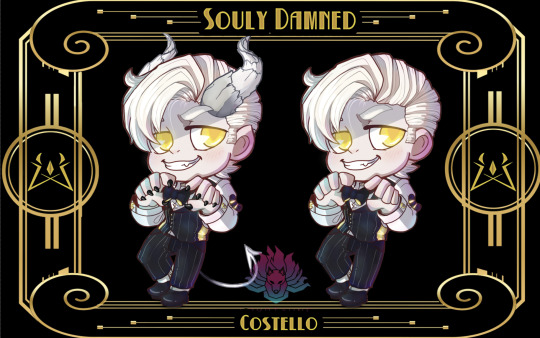
~Prince Profile:~
True Name: Saketh Alias Names: Costello Nicknames: N/A (he usually rarely even uses his true name as he prefers Costello far more) Soul Flower Type: Rose in Full bloom Color Type: Fire Gold mix with Burnt edges Infernal Hierarchy: Crowned Prince of Lust Age Order: 2nd Oldest Familiar Form: (Raven) - A large black feathered bird with eyes and talons of golden fire. True Form Appearance Description: ~Skeletal in appearance ~Prominent fangs (spiked teeth in true form) ~White horns similar to an antelope (more twisted) ~Fingers with black clawed tips ~Golden eyes ~Pointed gold tongue ~ Stereotypical spaded tail with a black to white gradient ~ Two sets of wings ~White to black gradient and edged with blue fire ~When in enraged they are fully engulfed in blue fire

Human Form Physical Description: ~Hair Color: warm tone Platinum Blonde ~Hair Style: Short, falls to ears, whip dip ~Glasses or Contacts: From time to time, more Rectangular frames ~Eye Color: Fire Gold ~Skin Tone: Pale ~Contract symbol mark placement: His left side, junction between neck and shoulder. ~Height -- 6’3”
Special Abilities or Powers --
~Mind reading ~Can pull out deepest desire ~Dream walking ~Veritas (forces those under his influence to tell the truth) ~Trust (will gain the trust of those touched) ~Mental Suggestion ~Lust Touch ~Levitation ~Teleportation ~Fire/Dark element ~Conjuration (more below cut!)
~SD Q AND A (These are all questions from you! Specifically those in my server):~
1. What was Costello like before he became an infernal?
💛 Costello used to be a Celestial of love just like Val. If you split love into two separate entities it would be the passionate romantic side and the side that is all about protection and devotion. These types also reflect in both Costello’s and Val’s Infernal sides. Costello is more about seduction and Val is about possession and obsession. As brothers they tend to work together in their celestial sides. When they fell they split a bit.
2. When he isn't busy what does he do in his spare time?
💛 Oh thats easy! During his time in the Mortal Realm he spent a fair amount of time in the 1920′s era. It is where his style comes from mainly and why the Lust kingdom appears to have that kind of influence within it. He used to be a charismatic bartender during prohibition and that has kind of stuck with him. He enjoys crafting new drinks both for mortals and Infernals (since they can’t get drunk off regular alcohol). He is also an avid reader.
3. What kind of stuff does he read?
💛 Hilariously he enjoys supernatural romance novels because they fascinate him. Why would mortals be interested in a being that could literally end their life easily? As one such being he finds it both amusing and curious. He also reading them to see what mortals are uh... "into". Other than that he likes reading anything supernatural/gothic fantasy based for “research”.
4. Does Costello share the same view on humans as Val?
💛 Val and he at one point help similar enjoyments fo mortal kind. They found that they were were entertaining and rather sweet to observe when falling in love. When they fell all they saw was darkness not just from mortals but also themselves. How lust overwhelms your thoughts and drives you to commit certain acts. Their opinions grew apart when Val was corrupted by their father, Darrius. They only were both brought back due to their brother Nas and the mortal they meet later in time, Evelyn Rodgers. Their nickname for her is Starlight.
5. Does Costello like animals?
💛 Yes he does! He has a specific affinity for the raven.
6. Does Costello have a favorite drink? Alcoholic and non alcoholic.
💛 He enjoys most drinks but specifically a Galaxy Cocktail but with an Infernal twist. When it comes to non-alcoholic I would say that he is more of a coffee connoisseur so things like Mocha. He enjoys sweet things but not to the level that Val does. (btw that cocktail looks like this)

7. Would Costello be willing to befriend humans?
💛 Before the fall, absolutely but after the Fall and before Eve? No. Humans are just tools for his amusement and entertainment. I should mention that Costello while his father is in power goes off the rails... and is extraordinarily dangerous only when Nas pulls him back from that does he mellow out. During the 1920's he still has a superiority mindset and a master of emotional manipulation. He is however far...FAR more mellowed out at this time which is why he humors Eve the first time they meet.
8. What are Costello’s responsibilities in his kingdom? 💛 It really depends on when in the timeline you are asking about. If we're talking before Nas ascends to the throne of the realm? Then Costello's duties were much less. He assisted Nas who was High Prince of Lust at the time. He studied and learned, ready to take over for Nas if the other needed to leave or otherwise. Now that he is High Prince himself? His duties include the hefty amounts of paperwork ensuring every soul is accounted for. New souls that hold purity to fall under Nas' new ruling, getting where they need to go if they landed in his kingdom. He also handles some punishments for the wicked. He has to run the entirety of Lust kingdom. Valentine... yanno... somewhere... X’D (trust me he probably isn’t the best one to ask)
~Souly Damned Timeline~
Creation of the Realms: The Celestial, Infernal, and First Mortal Realm come into being. The Infernal realm is closed off leaving the Celestials to guide and shape humanity. There are intermittent wars with the Infernal beasts and Imps when they manage to break their gates. The garden of Paradise was also created at this time which houses those most loyal to their “gods”. It is also a fact that the Celestial blooded creatures were created at this time (unicorns are a good example, light fantasy creatures). They were placed in the Garden.
The Celestial Civil War: Darrius and his sons rebel against the ways of the Silver City only to be stricken to the Infernal Realm. After this event the gates to the Celestial Realm are shut and mortals are forced to fend for themselves.
The Rise of the 12 Princes: The now fallen Celestials begin to corrupt the souls of the mortals present being known as the Seven Deadly Sins. The mortals are easily swayed by their new rulers dubbing them King and Princes. Each one with its own people and territory to preside over. In this time the Princes begin to succumb more deeply to their darker sides, now shunning their once Celestial blood.
Blood Moon: A period of time in between the rule of the Princes in the First Mortal Realm where 4 Princes began to experiment cruelly with their own corrupted blood and the mortal soul. The Infernal blooded hybrids come from this part of the timeline such as vampires, werewolves, and the fae.
The Vinculum Infernalis (Witches/Warlocks): With the Celestials gone the mortals were now forced to fend for themselves. In desperation they plead with their Fallen overlords to aid them. A blood binding contract was struck between them giving them magical abilities and a new tie to the Infernal Realm. This was also the creation of the first covens.
Maintaining the Balance (Hunters): Enraged by the tilt of the balance of the universe in Infernal favor the Celestials decide to form a similar bond with mortals creating the first Celestial blooded humans. They would eventually be called the Hunters as their “divine” task was to eradicate the First Mortal Realm of the Infernal Blooded abominations now that the Princes favored the newly created realm.
Long Live the King no more: After millenia of creating havoc and bloodshed without consequences the Princes begin to doubt the leadership of their father. They have slowly changed their mindsets about mortals all together after so much time. Instead of destroying everything in sight and soaking the earth with blood they begin to have an attachment. Their fathers' ways are despotic so in response to this Nasaros, the eldest, usurps his throne. A second war is waged between those of Infernal and Celestial blood turning the First Mortal Realm into an almost apocalyptic wasteland filled to the brim with monsters and ruins. The Princes lose the war doing substantial damage to the Celestial Realm. It was no longer habitable and so a new balanced realm was created for the mortals to live in peace without fear of Celestial driven war or demonic influences.
The Locking of the Gates: The gates of the three Realms are shut and locked in the beginning of the birth of the New Mortal Realm. The Princes are forced to make a new Kingdom within the Infernal Realm to which they have been banished. This forms “Hell” in which the decisions of a mortal's life determine where they go. If they revel in the original 7 sins then they are placed in the kingdom in which they over indulged in. The silver City was once again open to those of virtue but only after death. With no direct interference from either side the humans evolved and advanced on their own. This is what we know as the world today while the First Mortal Realm was now labeled as an in between realm. One that would eventually be called Purgatory, the realm of beasts, monsters, and the supernatural.
Bloodswap: A story set after the time frame of Blood Moon and the creation of the Hunters. It is about 2 brothers that become infected with a vampiric blood that is now turning their town to shambles. The gates have been sealed and those forced to live in Purgatory struggling to survive. The mortals have progressed slowly despite being an older realm. They are currently in what we would consider the middle ages with the help of Celestial technology. Once the gates are unsealed for the New Mortal Realm a new world order begins to form. (Crimson would be proud of his new vampiric race that has slowly taken over Purgatory, now more civilized as the rulers).
The New Mortal Realm and Purgatory: Purgatory remains in ruins though there are mortals that live in this apocalyptic wasteland of a world. That also includes monsters and hunters. Over the Centuries cracks within this forgotten realm have released some of its inhabitants into the New Mortal Realm (NMR). The original bloodline of the first covens also were able to make it into this new world fleeing from Purgatory with the help of their Infernal masters. The Mortal Realm is now in the modern day where many of the Infernal or Celestial blooded mortals or beasts hide in plain sight. Even some of the most vicious have adapted to this new apparently “magic-less” world.
Note: The gates are no longer locked indefinitely for either of the two main realms; this is why demons are able to make contracts with foolish mortals. The Celestials have been forbidden from interfering for fear of repeating the past but that does not mean that they do not do so. It is rumored that around the world are organizations created to combat in secret those Infernal blooded that lurk in the dark. Meanwhile the covens are more focused on their own material pursuits having been persecuted for centuries (Salem Witch Trials as an example).
Ossibus Inferni (1920’s; NMR):
-------------------------------------------------------------------------------------------
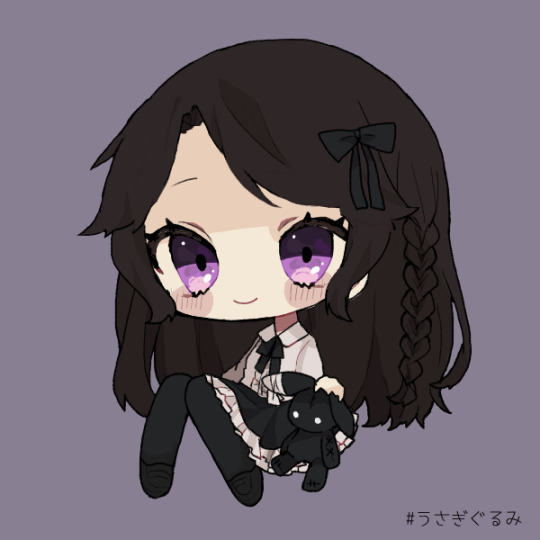
Main Plot Synopsis: During the era of the 1920’s a young lady named Evelyn Rodgers finds herself thrown into a Hellish Civil War. She is a small PI (Private Investigator) hurting for cash and jobs in a place wrought with problems. In an effort to make a better name for herself she begins to investigate the rise of crime and strange occurrences happening in her city. There are suspicious disappearances, missing persons reports, and extra violence that couldn’t be missed by human eyes, right? It just does not seem to add up. Determined and with nothing to lose she is able to put together a series of connections by using some none to savory contacts.
She finds out that the potential epicenter of these events are tied to owners of one of the swankiest and popular clubs in town. It is suspected that it is a speakeasy but that is not what has drawn her attention. It would appear that the family running the place have been a mystery to nearly everyone even though they have been around longer than they can recall. No one knows what the owners look like due to usually having their signature fedoras on. Ones that she can place all around the city through various photographs. It could be anyone, right?
Regardless of the information that she has collected she decides to go undercover to the club, Ossibus Ignem (Fire and Bone), in order to confirm her suspicions. She decides that auditioning for one of their most prized gigs is a good way to get into their inner circle and perhaps get a glimpse of her potential employers. Eve wants the truth and nothing but the truth though this plan is incredibly risky. Even if the brothers, as she finds out later, are not the cause of these events they could still be nefarious. No one likes a spy, especially one that’s gained their trust.
As she enters she realizes that it is packed like the rumors have told her. She does not get out much due to her job but she is dressed to the 9s in a beautiful dress of the time ready to put her plan into effect. Instead of waiting around she heads to the bar where she is spotted by the seemingly charismatic bartender which she manages to strike up a conversation with. She tries to pick his brain over a drink that he generously slides her way. It would seem that the establishment is already breaking the laws of Prohibition. That much is already confirmed.
He seems like the friendly sort, platinum blonde hair and a dazzling smile. Eve being a PI calls into question how perfect he actually looks but puts the thought off. She could have sworn his eyes were far more vibrant than what was humanly possible too. When she glances at him again however they appear to be a light brown instead. Things are already strange as she continues to speak with him only to find out that he is in fact one of the brothers that work at the club. It turns out to be a family business. He introduces himself as Costello -.
Eventually their conversation is cut short by Costello taking her to the back of the house where presumably his brother is waiting for her to do her little gig. She paces back and forth nervously in her dressing room only to not watch where she is going, running into a tall individual. His pinstripe suit, fedora, and bright red tie cause her to pause only to be greeted with a shiny golden toothed smile. The strange thing about it is that it is shaped into a fang/ canine tooth. It is a little off putting but the stranger introduces himself as the younger brother of the group, Valentine -.
This is someone that she had no doubt is in all the photographs that she had collected. Ultimately he seems nice enough telling her that if she needs anything to let him know and to take her time with her audition. He does appear to have a mischievous flirty side to him especially with her which she tries to distance herself from. He does not make that easy as she can tell he has already taken a special interest in her.
She performs and it would seem that she has a pretty singing voice that leaves the entire crowd roaring in applause. This obviously catches the eyes of the brothers and she gets the gig. Other than a few of the accidental slip ups the boys seem fine with her being around them. She doesn’t pose any threat. After all, she is only human.
Eve begins to enjoy her undercover position but finds herself slipping further and further away from her original objective. The - family puts her up in the loft above the club and treats her well. She learns more about them and more about the family itself. They are pretty open with what they do not even hiding the crime lord status that they are under. Being associated with the brothers is dangerous and therefore they want to make sure she understands what it means to be under the name of -.
She is surprised by their honesty and immediately they gain her trust and vice versa. That is until she realizes why she is there in the first place. After one of her performances she manages to get into Valentine’s room, snooping around. Only to find something she wasn’t expecting of a bunch of crime mafiosos. Instead she finds arcane symbols, tomes, and various other occult items that would lead her to the conclusion that they are in fact dealing with something far beyond the mortal realm. At least that is what she thinks.
The concern only grows when she finds a secret room with even more devilish items. One such item is a series of documents showing the various victims she had been investigating. On top of that information she finds even darker dealings then she suspected and papers scrawled with a script she has never seen before. As she turns to leave the room she freezes to hear Valentine’s voice. He is none too thrilled as he interrogates her but she can’t see his face. All she can feel are skeletal like claws at her shoulders. It’s all in her head right?
When he turns her around she is faced with him looking quite human explaining to her the predicament she now finds herself in. As her confusion grows he keeps her cornered only to be given two choices. One is that she binds her soul to him in the form of a contract and the other, death. Obviously she chooses to live. After this event she is able to see the true forms of all the Infernals in the club, having a panic moment seeing them mingling so easily with unsuspecting humans. Valentine, Luciano, and Costello are the most terrifying in form as they are skeleton looking Infernals. From then on she works in the club learning more and more about their true selves.
<< PREV | FIRST | NEXT >>
#demons#Souly Damned#SD Saturdays#worldbuilding#info#askbox is open#orignal content#angels#costello#Saketh
26 notes
·
View notes
Text
Akhenaten
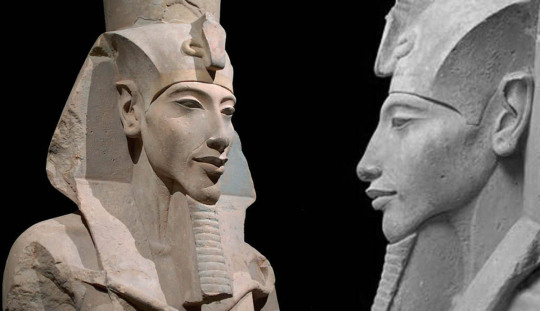
The name Akhenaten is rather well known as a Pharaoh of Egypt. Like Ramesses II, Hatshepsut, Cleopatra, and Tutankhamun, Akhenaten won the popularity contest of modern society through defining himself as far different from most other Pharaohs. With Akhenaten, however, he’s not even like the special Pharaohs.
Let’s look a little at his life and the history of the time period he ruled over. He was in the 18th Dynasty of the New Kingdom, from 1353-1336 BC. Like most Pharaohs there are a few different pronunciations of his name, including Akhenaton, Ikhnaton, Khuenaten, all meaning of great use to Aten, which leads into his conversion into the cult of Aten. Before the conversion his name was Amenhotep IV, son of Amenhotep III. His mother was named Tiye. Later on in life he married Queen Nefertiti, fathering two children, one from his wife Nefertiti and one from his lesser wife, Lady Kiya, having Ahnksenamun and Tutankhamun to each wife respectively.
Before we get into the whole mess of his religion and the ‘revamping’ he did of ancient Egypt, let’s recognize the other things he did for or to the country.
You’ll recognize the vastly different art style between Akhenaten’s rule and the history of most of Egypt. In art that depicts Akhenaten, he was shown as long and spindly, a style that carried into his family. Some people believe that this was because he and his family suffered from Marfan’s syndrome, a disease that caused the elongation of bones and skinniness. A more likely explanation stems from the Pharaoh’s religious beliefs, which as you know, was vastly different from other Pharaohs. This theory is a little more likely because there was no reason for the queen Nefertiti to have the same condition as her husband. Instead, it was probably because their status was far different from the other Pharaohs, as they were moved into a genuinely god-like status for their worship of Aten.
The part of Akhenaten and his rule that interests me the most is the way the royal family was presented in art, despite the style. Like many parts of Akhenaten, it’s entirely different from other Pharaohs (though, whether that’s good or bad is up to you).
Now, most Pharaohs presented themselves highly in art. They could do that, so why not? If I had the guts and the money I probably would too, but my point is that essentially all Pharaohs depicted themselves alone on stelas, engaging in hunting or other activities that strengthened the image of themselves that they wanted to show the world. Usually they were masculine tasks that could be done only by those with great strength and great riches. Akhenaten went in an entirely different direction; he depicted himself with his family. In the stele of Akhenaten, he is shown in a private way, the scene being him with his family, enjoying themselves together.
While we can’t say the definitive reason for him presenting himself as this, the most logical conclusion has to do with, again, his religious beliefs. In his mind, the Aten was held above all else, even the Pharaoh. With Aten as the highest consideration, the Pharaoh and his family enjoyed their lives under the influence of the Aten’s love and grace.
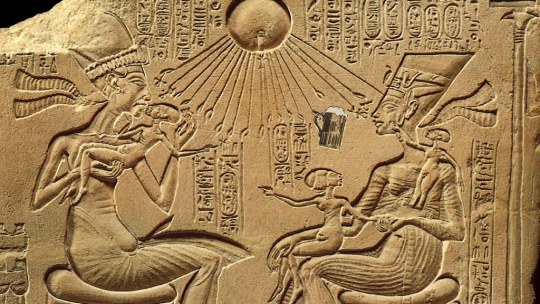
Now that we have a little insight, let’s get into the whole mess of his religion that died immediately after he did.
Akhenaten originally reigned as Amenhotep IV, a reign that lasted around five years before he switched religions. Changing his name, he converted to a cult that worshipped Amun to that of Aten, abolishing the ancient rites of those before him, and instituting what is believed as the first example of monotheism state religion in the world. His rule as Akhenaten lasted 12 years, during which he was labelled as the infamous ‘heretic king’, so that should give you some insight into how people felt about him.
Before his rule, the cult of aten was a cult like all others in Egypt. It was a bit like choosing your favorite God – find the one you like most, and join that cult. For example if I were to join a cult, I would join the cult of my favorite God, Ma’at. I mention this because before the change, the Aten was shown in inscriptions of Akhenaten (Amenhotep IV at that point), represented by the sun disk. It’s also important to note cult doesn’t carry the same meaning as it did then, and each cult shared the same goal: balance and eternal harmony.
At the time of Amenhotep IV’s rule the Amun cult (where the Aten is from) held incredible power. Their power had been growing for a long while, and by the time of his rule, they held nearly as much power and riches as the Pharaoh himself, and actually owned more land than Amenhotep IV. The fifth year of his reign he switched everything; this was when he abolished the practices of the previous religion of Egypt, and proclaimed himself the “living incarnation of a single all-powerful deity known as Aten,” (Joshua J Mark), and by the ninth year, he closed every single temple, prohibiting all the old practices and devotion to the many Gods the people of Egypt worshipped.
Around then was when he moved the royal seat of Egypt from the traditional house of Thebes to a city of his own creation, a city named Akhetaten, and with that he changed his name to Akhenaten. Here he earned the name the Heretic King, earning the ire of some historians and the admiration of others.
Despite the fact that Akhenaten’s influence completely destroyed worship of the Gods many Egyptians loved, one of the main problems with his rule was that the Old Gods of Egypt instilled harmony and order in the citizens, ultimately helping to create a country that lasted over 4,000 years. Without these Gods, things got a little wonky.
Religious tolerance was allowed with the many Gods, emphasizing peace to the point where religious intolerance wasn’t even an issue. Unfortunately, for monotheism to work, there has to be something inherently wrong with the other side, which made Akhenaten’s work a lot harder, and its’ effects much stronger. It led to the intolerance of other beliefs and some severe suppression, and if you look at the monotheistic religions of today, you can see the same sort of pattern. With intolerance comes hatred and war.
“Dating to this point in Akhenaten’s reign was a campaign to excise the name of gods other than the Aten, especially Amun, from the monuments of Egypt. This was done with violence: hieroglyphs were brutally hacked from the walls of temples and tombs. This was probably carried out, at least in part, by illiterate iconoclasts, presumably following the orders of their king. [Akhenaten] carried out a religious revolution the like of which had never been seen before in Egypt.” (Zahi Hawass, 42-43).
There were priests of Atum who attempted to hide religious artifacts, storing statuary and texts away from the soldiers ordered to destroy them. The priests, with nothing left to do, were forced to abandon their temples. In response Akhenaten either hired new priests or forced the other ones to obey him, proclaiming him and his wife once more as Gods on earth.
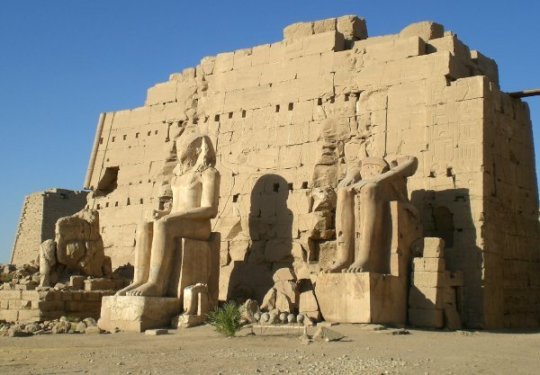
Now you can see how Akhenaten kind of sucks. Let’s talk about how he sucks even more.
His foreign policy.
With his ego inflated to the size of the sun, Akhenaten thought himself above interactions with foreign powers. He left his duties to spend more time on himself and his family, ultimately leading to a severe neglect.
You might be asking, “didn’t every Pharaoh have a super-inflated ego?” and yes, you’d be right, but no Pharaoh before Akhenaten had genuinely claimed themselves to be a God. As a self-proclaimed incarnated God, he must’ve thought such affairs beneath him.
Discovered through letters of the time, several (former) allies of Egypt had asked for their help several times with various affairs. At the time Egypt was wealthy, prosperous, and strong, a state that had been slowly growing before halting at Queen Hatshepsut’s reign. Hatshepsut and her successors employed a strategy of actually doing work, by working out when to approach with diplomacy, and when military action was required. Akhenaten on the other hand, ignored everything outside of his palace at Akhetaten.
The uncertainty of Akhenaten’s rule, along with letters of correspondence between the city of Amarna, the Pharaoh, and foreign nations, led to this era being called the Amarna period. These very letters were proof of the Pharaoh’s negligence. However, the letters also show his keen eye in foreign diplomacy, if the situation interested him so. It was a whole thing with the Hittites, but since this is chiefly about Akhenaten, I’ll leave that topic for later. All you really need to know is that he only tended to issues that affected him directly, and through the Amarna letters, historians can see how poor of a King he was, as well as how deeply many of his subjects disliked or despised him.
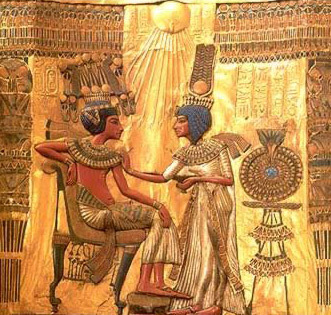
Essentially, the main reason this mess didn’t work out was because it brought about something new: exclusivity. And the Egyptians did not like that, believing that the world needed to have a balance in order to stay away from slipping into chaos. In the end monotheism didn’t last; hell, it was ended basically the second Akhenaten’s son took the throne. Tutankhamun, originally named Tutankhaten, changed his name to reflect the return to polytheism. His successors tore down the reminders of Akhenaten’s reign, removing him and his adoration for the Aten, eradicating his name from the record.
There’s no saying he didn’t affect the world – he did, a lot. Whether that affect was good or bad is up to the interpreter (personally I don’t like it all that much). By Freud’s thinking (hear me out, I know he sucks) Akhenaten’s rule inspired the ancient world, leading others to copy his ideas and theology, eventually snowballing into our modern world, where there are essentially no polytheistic religions. You have to give him credit – he was the first person of the ancient world to dream up monotheism, changing what had defined humanity for so long.
With his name stricken from the books, historians only discovered him upon finding his city Akhetaten. In the records, Horemheb is labelled as Amenhotep III’s successor, skipping over both Akhenaten and Tutankhamun’s rule. Later when Tutankhamun’s tomb was found as one of the very few graves still filled with treasure, interest spiked in Tutankhamun’s life, eventually leading back to his father Akhenaten.
88 notes
·
View notes